Technicolor Delivery Technologies Belgium TG585V7 ADSL Modem User Manual ST585v6 InstallSetup en
Technicolor Delivery Technologies Belgium ADSL Modem ST585v6 InstallSetup en
Contents
- 1. Manual 1
- 2. Manual 2
Manual 1
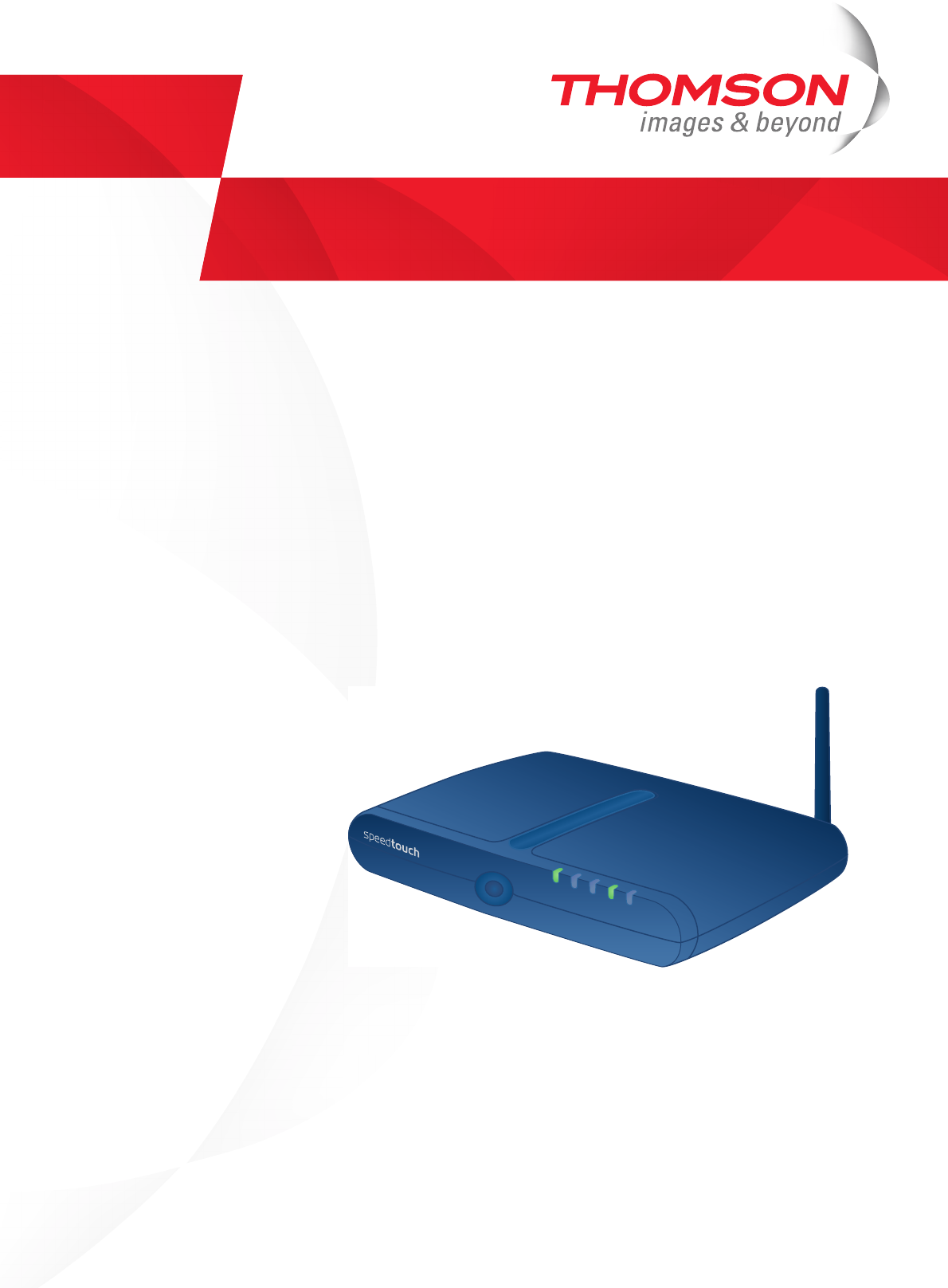
Power
WLAN
Ethernet
DSL
Internet
Thomson ST585(v6)
Installation and Setup Guide

Thomson ST585(v6)
Installation and Setup Guide

Copyright
Copyright ©1999-2007 Thomson. All rights reserved.
Distribution and copying of this document, use and communication of its contents is not permitted without written authorization
from Thomson. The content of this document is furnished for informational use only, may be subject to change without notice,
and should not be construed as a commitment by Thomson. Thomson assumes no responsibility or liability for any errors or
inaccuracies that may appear in this document.
Thomson Telecom Belgium
Prins Boudewijnlaan, 47
B-2650 Edegem
Belgium
http://www.thomson-broadband.com
Trademarks
The following trademarks are used in this document:
>DECT is a trademark of ETSI.
>Bluetooth® word mark and logos are owned by the Bluetooth SIG, Inc.
>Ethernet™ is a trademark of Xerox Corporation.
>Wi-Fi® and the Wi-Fi logo are registered trademarks of the Wi-Fi Alliance. "Wi-Fi CERTIFIED", "Wi-Fi ZONE", "Wi-Fi Alli-
ance", their respective logos and "Wi-Fi Protected Access" are trademarks of the Wi-Fi Alliance.
>UPnP™ is a certification mark of the UPnP™ Implementers Corporation.
>Microsoft®, MS-DOS®, Windows® and Windows NT® are either registered trademarks or trademarks of Microsoft Corpo-
ration in the United States and/or other countries.
>Apple® and Mac OS® are registered trademarks of Apple Computer, Incorporated, registered in the United States and
other countries.
>UNIX® is a registered trademark of UNIX System Laboratories, Incorporated.
>Adobe®, the Adobe logo, Acrobat and Acrobat Reader are trademarks or registered trademarks of Adobe Systems, Incor-
porated, registered in the United States and/or other countries.
Other brands and product names may be trademarks or registered trademarks of their respective holders.
Document Information
Status: v1.0 (January 2007)
Reference: E-DOC-CTC-20060911-0041-
Short Title: Installation and Setup Guide ST585(v6) R6.2

E-DOC-CTC-20060911-0041- v1.0 i
Contents
About this Installation and Setup Guide.................................. 1
1 Introducing the Thomson Gateway........................................... 3
2 Basic Installation.......................................................................... 5
2.1 Mounting your Thomson Gateway .................................................................. 6
2.2 Installing your Thomson Gateway .................................................................. 7
2.2.1 Guided Installation ................................................................................................................................. 8
2.2.2 Manual Installation............................................................................................................................... 16
2.3 The Setup CD ................................................................................................ 18
2.4 Thomson Gateway Connection Essentials .................................................... 20
2.5 Connections Overview and Powering ........................................................... 21
2.5.1 Wireless Setup...................................................................................................................................... 22
2.6 Basic Security ............................................................................................... 24
3 Web-Based User Interface ........................................................ 27
4 Troubleshooting ........................................................................ 29
4.1 Checking the Hardware................................................................................. 30
4.2 LED Diagnostics ............................................................................................ 31
4.3 Web Diagnostics ........................................................................................... 33
4.4 Thomson Gateway Setup CD Troubleshooting ............................................. 35
4.5 Windows Zero Configuration ........................................................................ 38
4.6 Easy Setup Troubleshooting ......................................................................... 40
4.7 Reset to Factory Defaults ............................................................................. 41

E-DOC-CTC-20060911-0041- v1.0
Contents
ii

E-DOC-CTC-20060911-0041- v1.0 1
About this Installation and Setup Guide
About this Installation and Setup Guide
Symbols Used
Terminology
Generally, the Thomson ST585(v6)(i) will be referred to as Thomson Gateway in this Installation and Setup
Guide.
Typographical Conventions
Following typographical convention is used throughout this manual:
>Sample text indicates a hyperlink.
Example: For more information, visit us at www.thomson-broadband.com.
>Sample text indicates an important content-related word.
Example: To enter the network, you must authenticate yourself.
>Sample text indicates a GUI element (commands on menus and buttons, dialog box elements, file
names, paths and folders).
Example: On the File menu, click Open to open a file.
Documentation and software updates
Thomson continuously develops new solutions, but is also committed to improving its existing products.
For suggestions regarding this document, please contact documentation.speedtouch@thomson.net.
For more information on Thomson's latest technological innovations, documents and software releases, visit
us at http://www.thomson-broadband.com.
iA note provides additional information about a topic.
!A caution warns you about potential problems or specific precautions that need to be taken.

E-DOC-CTC-20060911-0041- v1.0
2
About this Installation and Setup Guide
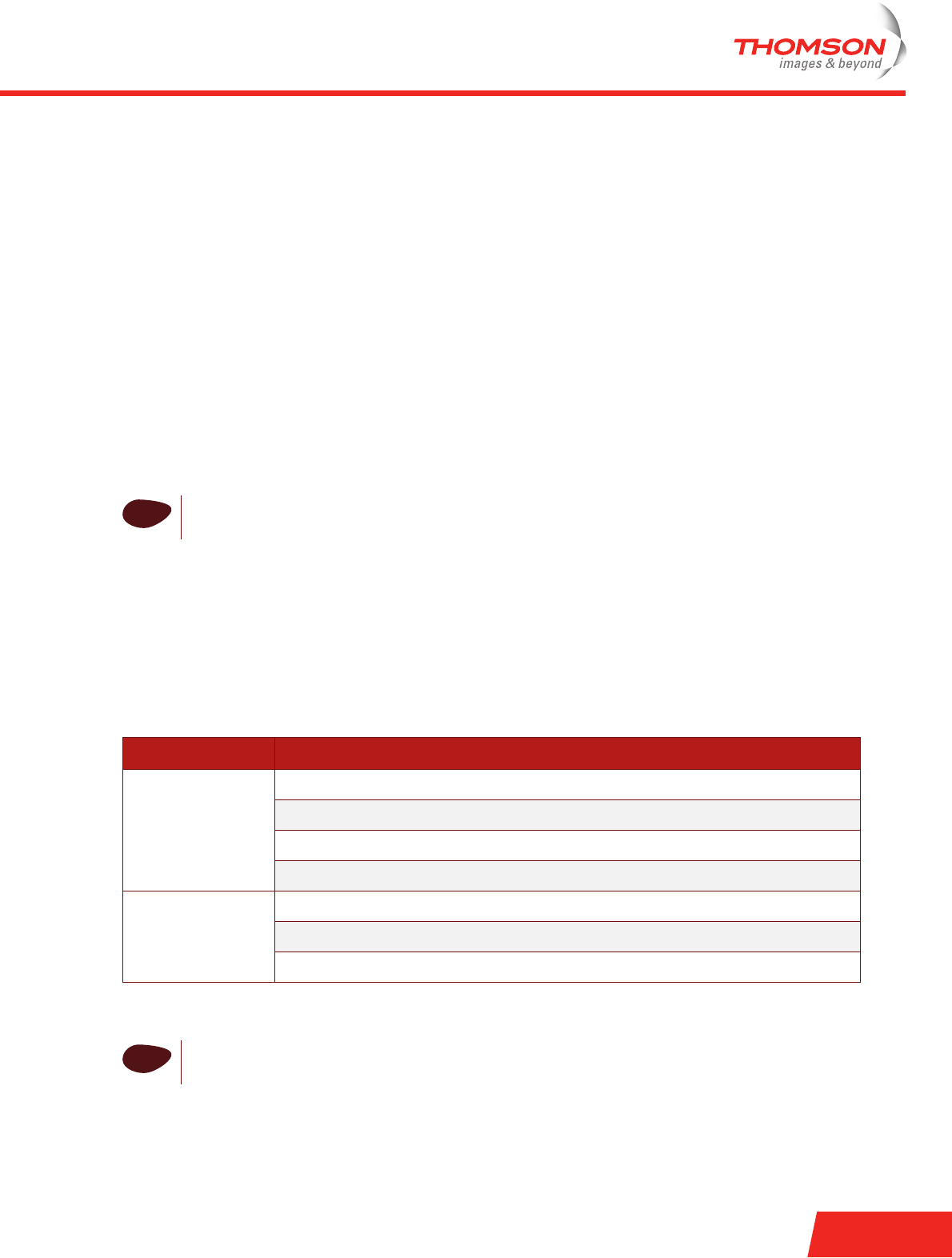
E-DOC-CTC-20060911-0041- v1.0
Chapter 1
Introducing the Thomson Gateway
3
1 Introducing the Thomson Gateway
Introduction
In a minute you will be able to access the Internet using your Thomson Gateway.
This Installation and Setup Guide will show you how to set up your Thomson Gateway and how to connect a
computer or a Local Area Network (LAN) to the Internet.
Identifying your Thomson Gateway
The label on the bottom of your Thomson Gateway informs you about the Thomson Gateway’s:
>Product name
>Model number
>Serial number
>Power requirements
DSL variants
The Thomson Gateway comes in two ADSL variants:
>POTS: The Thomson ST585(v6) connects to an analogue Plain Old Telephone Service (POTS) line.
>ISDN: The Thomson ST585(v6)iconnects to an Integrated Service Digital Network (ISDN) line, enabling
residences with an ISDN line to use the ADSL service.
You can easily identify your variant by checking the product name printed on the label on the bottom of your
Thomson Gateway.
!Do not remove or cover the label.
The ... variant supports ...
POTS ADSL
ADSL2
ADSL2+
RE-ADSL
ISDN ADSL
ADSL2
ADSL2+
!Only use the Thomson Gateway variant which is appropriate for the DSL service provided to your
premises.

E-DOC-CTC-20060911-0041- v1.0
Chapter 1
Introducing the Thomson Gateway
4

E-DOC-CTC-20060911-0041- v1.0
Chapter 2
Basic Installation
5
2 Basic Installation
Before you begin
Make sure you read the safety instructions and regulatory notices first. You can find the safety instructions on
the Setup CD (see “2.2 Installing your Thomson Gateway” on page 7). They may also be provided as a
printed booklet.
ADSL service
The ADSL service must be up and running on your telephone line.
If both conventional telephone and ADSL service are simultaneously available from the same copper pair,
you will need a central splitter or distributed filters for decoupling ADSL and telephone signals.
Computer requirements
>To connect computer(s) via Ethernet, make sure the computer(s) are equipped with an Ethernet network
interface card (NIC).
>For wireless networking, you will need a wireless 802.11 b/g compatible client adapter for each computer
you intend to connect wirelessly.
Wireless client adapters
You can use one of the following wireless client adapters:
>Thomson ST110g CardBus
>Thomson ST121g USB adapter
>Thomson ST122g USB adapter
>Any other Wi-Fi certified WLAN client
Internet connection details
You need the following connection details from your Internet Service Provider (ISP):
>Your ISP’s method for connecting to the Internet (for example PPPoE)
>The VPI/VCI (for example 8/35)
>Your user name and password to connect to the Internet
You must have received this information when you subscribed to DSL at your Internet Service Provider (ISP).
You will be prompted for this information at a given step in the installation procedure.
!Public telephone lines carry voltages that can cause electric shock. Only try to set up splitter/filters
that have been designed to be installed by unqualified personnel. For further assistance, contact
your Internet Service Provider.
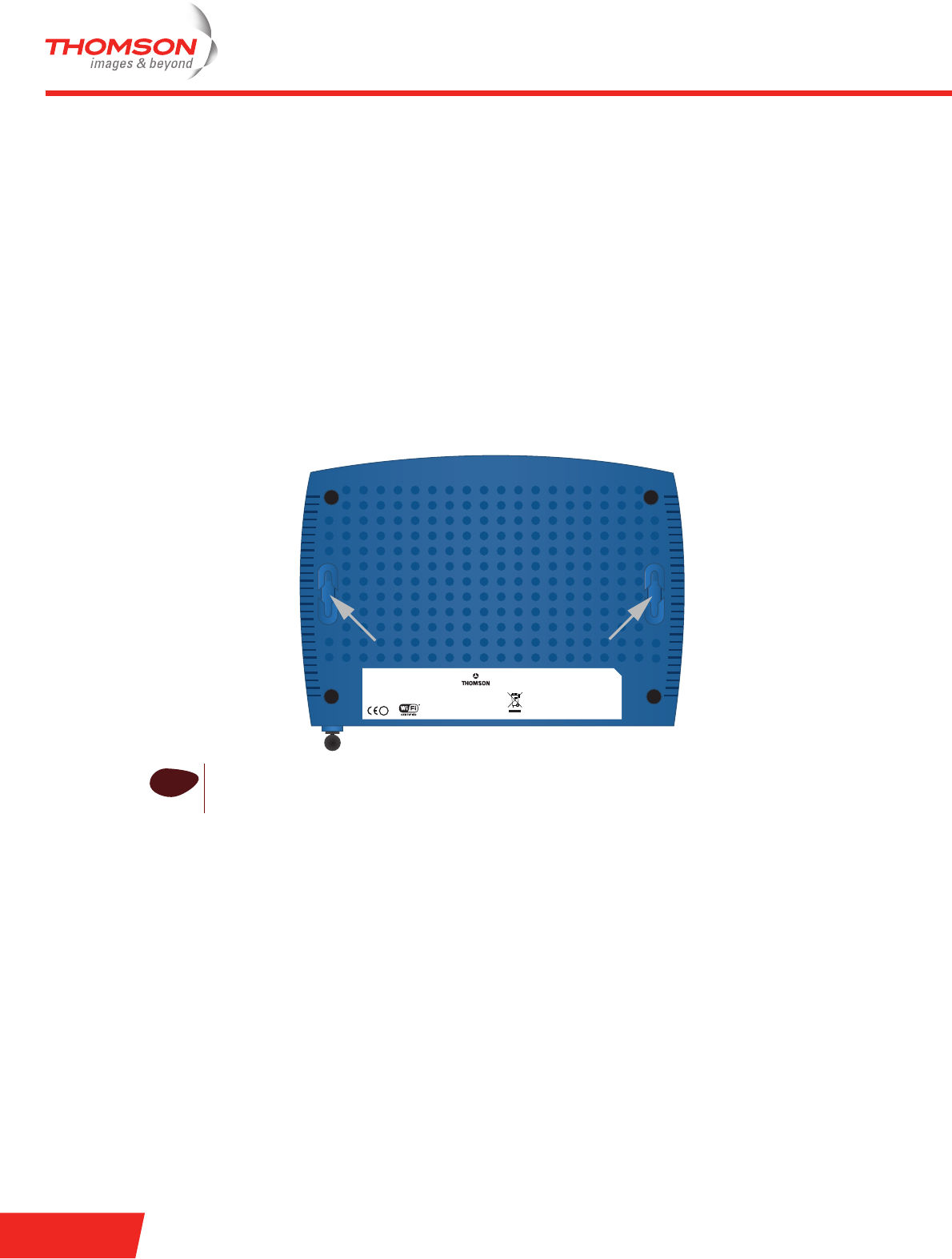
E-DOC-CTC-20060911-0041- v1.0
Chapter 2
Basic Installation
6
2.1 Mounting your Thomson Gateway
Setup possibilities
You can mount the Thomson Gateway on a wall or simply place it on a desk.
Wall mount
Proceed as follows to mount the Thomson Gateway on a wall or other vertical surface:
1Drill two holes in the wall or other vertical surface where you want to place the Thomson Gateway.
2Fasten two screws in the wall holes. The screws should protrude five millimetres from the surface of the
wall.
3Attach your Thomson Gateway on the wall using the two mounting slots on the bottom.
iIf you install the Thomson Gateway onto plasterboard, use dowels to secure the screws.
Otherwise the strain of the cables connected to the Thomson Gateway rear panel connectors
could pull the Thomson Gateway from the wall.
MODEM ACCESS CODE: 0123456789
MAC: AAABCCCDDEEE
THOMSON TELECOM
*ACCESS CODE 0123456789*
*MACADDRESS AAABCCCDDEEE* SSID:SoeedTouchVVVVVV
WEP (hex):1234ABCDEF
WPA PSK: 1234ABCDEF
TCM: 12345670
SpeedTouch ZZZ
DSLBSFFFFF RQQI
S/N:CPYYWWPPXXX (CC)
*DSLBSFFFFF RQQI*DSLBSFFFFF RQQI
*MACADDRESS AABCCCDDEEE*
RATED INPUT: 18V~
1000mA
!
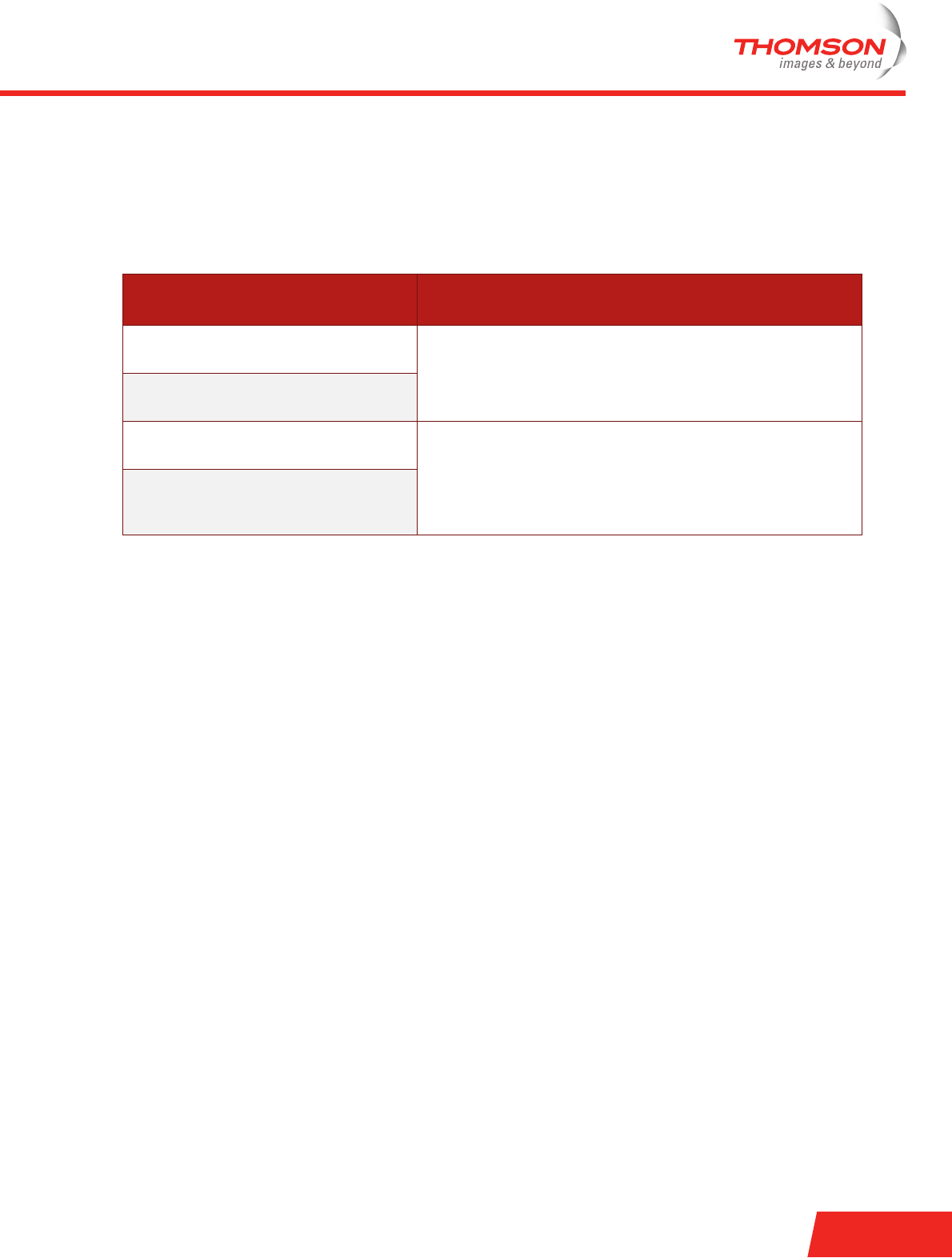
E-DOC-CTC-20060911-0041- v1.0
Chapter 2
Basic Installation
7
2.2 Installing your Thomson Gateway
Internet connectivity setup
There are different ways to set up your Thomson Gateway. The best way depends on your operating system.
If you use the following operating
system
the recommended way to set up your Thomson
Gateway is
Microsoft Windows (98 SE, Millennium,
2000 or XP)
the Home Install Wizard, as described in “2.2.1 Guided
Installation” on page 8.
Mac OS X, provided you use a wired
connection to your Thomson Gateway
Any operating system (provided you
have IP connectivity)
the Easy Setup, as described in “2.2.2 Manual Installation” on
page 16.
Mac OS X, wirelessly connected to your
Thomson Gateway and provided you
have IP connectivity

E-DOC-CTC-20060911-0041- v1.0
Chapter 2
Basic Installation
8
2.2.1 Guided Installation
Introduction
On the CD, a Quick-Install Wizard is provided that will guide you through the first installation and setup of
your Thomson Gateway.
The Quick-Install Wizard will:
>Provide important safety and regulatory information.
>Show you how to make the necessary connections to your Thomson Gateway.
>Show you how to turn on your device.
>Prepare you to smoothly run the Thomson Gateway Home Install Wizard.
The subsequent Home Install Wizard will then prepare your Thomson Gateway and your local computer(s) to
connect to the Internet.
The Home Install Wizard will:
>Guide you through connecting your computer(s) to your Thomson Gateway.
>Prepare the Thomson Gateway to connect to the Internet.
Connecting the cables: wait!
Do not plug in any cables until you are prompted to do so by the Quick-Install Wizard and/or the Home Install
Wizard.
Starting the CD for the first time
To start the Thomson Gateway Setup:
1Insert the Setup CD into your computer's CD-ROM or DVD-ROM drive.
Microsoft Windows: The CD should autostart.
Mac OS X: Double-click Menu in the window with the content of the CD.
2Select the language of your choice and click OK.
3The procedure continues with the Quick-Install Wizard.
Proceed with “ Quick-Install Wizard” on page 8.
Quick-Install Wizard
The Quick-Install Wizard guides you through the first setup of your Thomson Gateway.
1On the Welcome page, click Next to continue.
!You need administrative rights to run the applications on the Setup CD on a Microsoft Windows
2000 or XP operating system, or Mac OS X computer.
!If not, see ”The Thomson Gateway CD does not start automatically” on page 35.
!If you ran the CD on this computer before, the Quick-Install Wizard is not shown; the CD menu
appears instead (see “2.3 The Setup CD” on page 18 for more information).
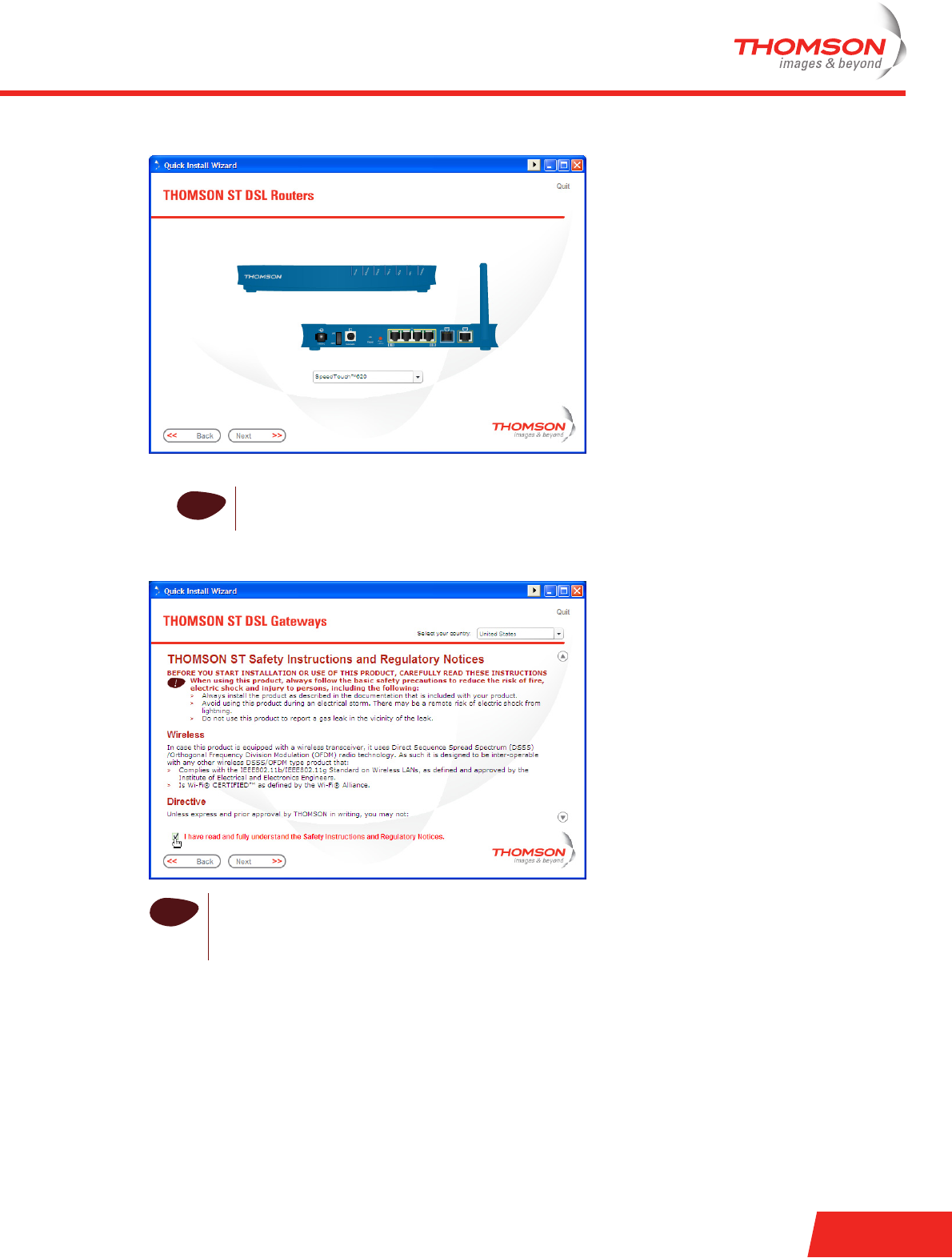
E-DOC-CTC-20060911-0041- v1.0
Chapter 2
Basic Installation
9
2Select your Thomson Gateway from the list of supported devices and click Next.
The Thomson Gateway Safety Instructions and Regulatory Notices are displayed.
3Scroll down and read all the instructions carefully, select I have read and I fully understand the Safety
Instructions and Regulatory Information to confirm your reading, and then click Next.
4Subsequent screens guide you through the preliminary hardware setup of your Thomson Gateway.
Follow all the instructions carefully and click Next each time your are ready to proceed.
5Click Set up my THOMSON ST to continue.
6The procedure continues with the Home Install Wizard.
Proceed with “ Home Install Wizard” on page 10.
iA product picture helps you to easily identify your Thomson Gateway. If you are not sure
what device you have, check the label on the bottom of your Thomson Gateway.
!Your Thomson Gateway is designed and tested to meet the latest safety standards. However, to
ensure safe use of this product, it is important that you carefully read and comply with the
Safety Instructions and Regulatory Notices shown and/or available in the Safety and
Regulatory booklet before you install the Thomson Gateway.
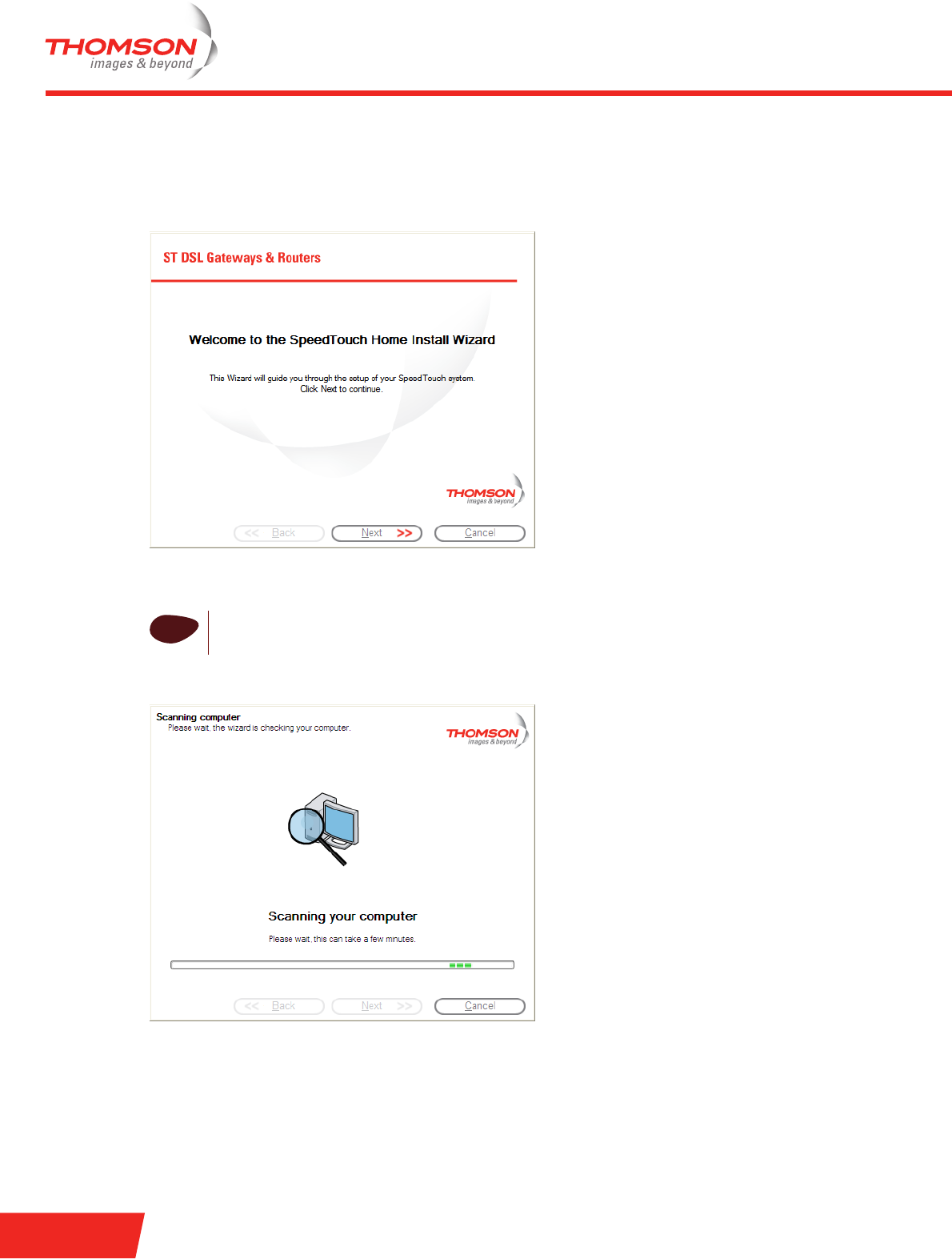
E-DOC-CTC-20060911-0041- v1.0
Chapter 2
Basic Installation
10
Home Install Wizard
The Home Install Wizard guides you through your local network connections and prepares the Thomson
Gateway to connect to the Internet. Proceed as follows:
1On the Welcome page, click Next to continue.
The Software License Agreement window appears.
2You must accept before continuing. Click Yes to accept.
The Home Install Wizard checks your system and invites you to connect the Thomson Gateway to your
computer.
!If you accepted the Software License Agreement in a previous configuration setup, this window
will not be shown.

E-DOC-CTC-20060911-0041- v1.0
Chapter 2
Basic Installation
11
3Make one of the following connections:
Connect the yellow RJ-45 Ethernet cable to the yellow (indicated) Ethernet port on your Thomson
Gateway and the other end to the computer’s Ethernet port.
For wireless networking, plug a wireless card or adapter into your computer.
4Once the hardware is installed and connected to the Thomson Gateway, the procedure continues with
configuring your Internet connection.
Proceed with “ Configuring the Internet connection” on page 12.
iIn case of problems or for advanced information, see “2.5.1 Wireless Setup” on page 22.
iIf the wizard does not detect a connection, an error message will be displayed. Refer to “The
wizard does not detect a connection” on page 35.
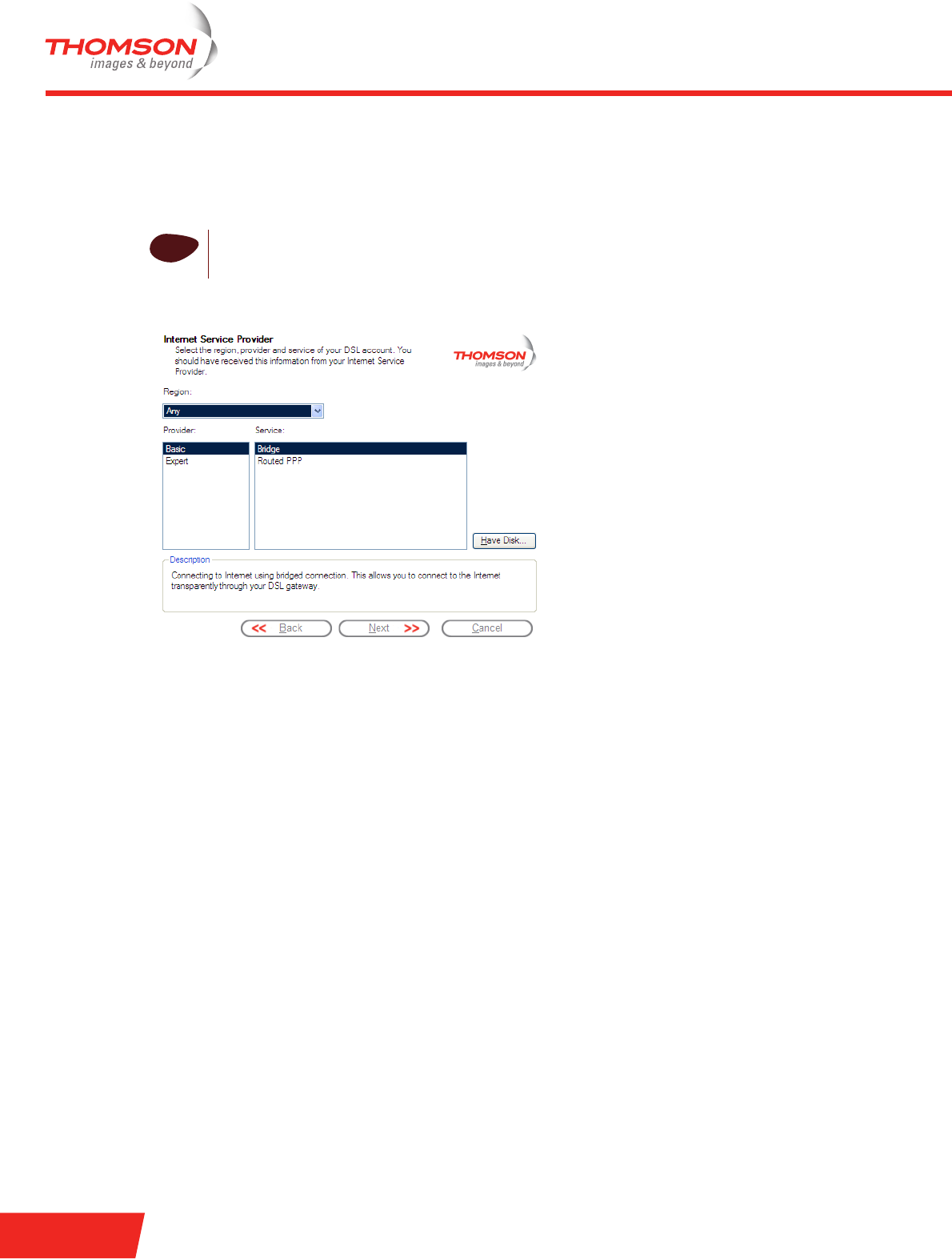
E-DOC-CTC-20060911-0041- v1.0
Chapter 2
Basic Installation
12
Configuring the Internet connection
Proceed as follows:
1If prompted, enter the User name and Password for your Thomson Gateway security settings and click
OK.
2Select the appropriate Region, Provider and Service for your Internet connection as specified by your
Internet Service Provider and click Next.
3Your connection to the Internet connectivity is set up:
Select the VPI/VCI - and, if required, the Connection Type - as specified by your Internet Service
Provider and click Next.
Enter the User Name and Password for your Internet account settings as specified by your Internet
Service Provider and click Next.
4The procedure continues with some additional configurations.
Proceed with “ Configuring the Thomson Gateway (and your computer)” on page 13.
iThe factory default user is ‘Administrator’ and its password is blank. It is advisable to specify
another user name and password during the configuration procedure to protect your Thomson
Gateway from security violation. See “2.6 Basic Security” on page 24 for more information.
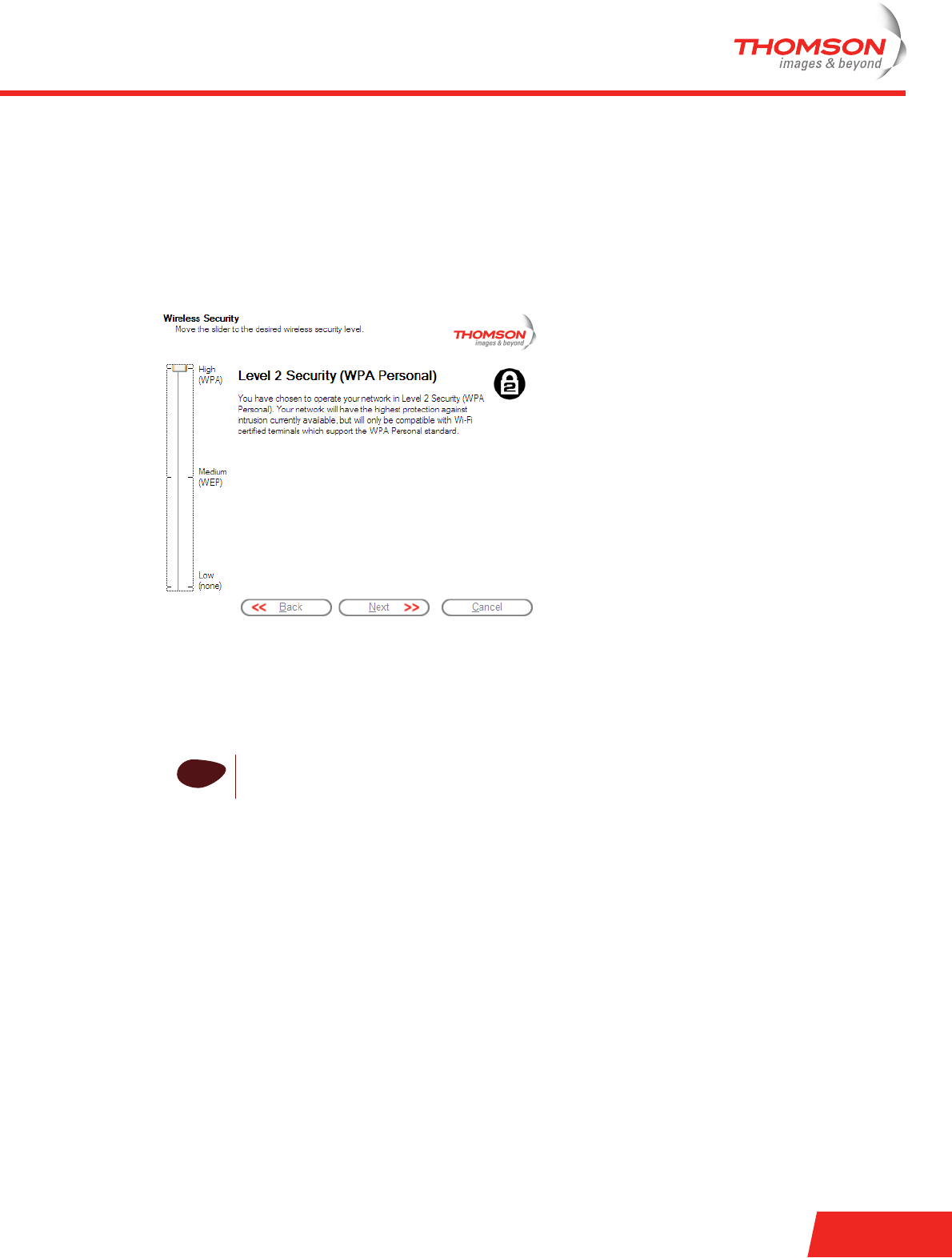
E-DOC-CTC-20060911-0041- v1.0
Chapter 2
Basic Installation
13
Configuring the Thomson Gateway (and your computer)
Proceed as follows:
1Depending on the selected service profile and your ISP’s requirements, you may have to fill in some
additional settings during the Home Install Wizard, like Dynamic DNS Service, Time Configuration or
other.
Enter the information provided by your ISP and click Next whenever requested.
2To protect the wireless connections to your Thomson ST, move the slide control to the desired security
mode.
The following security modes to secure traffic between the Thomson Gateway and connected wireless
stations are available:
Low, which implies in fact that no security measures are taken at all.
Medium, implying that traffic is encrypted by means of a static encryption key (WEP).
High, providing the highest security standard available (WPA) for encrypting all wireless traffic.
iFor an overview of all Thomson Gateway wireless security features, see “ Securing your
wireless network” on page 24.
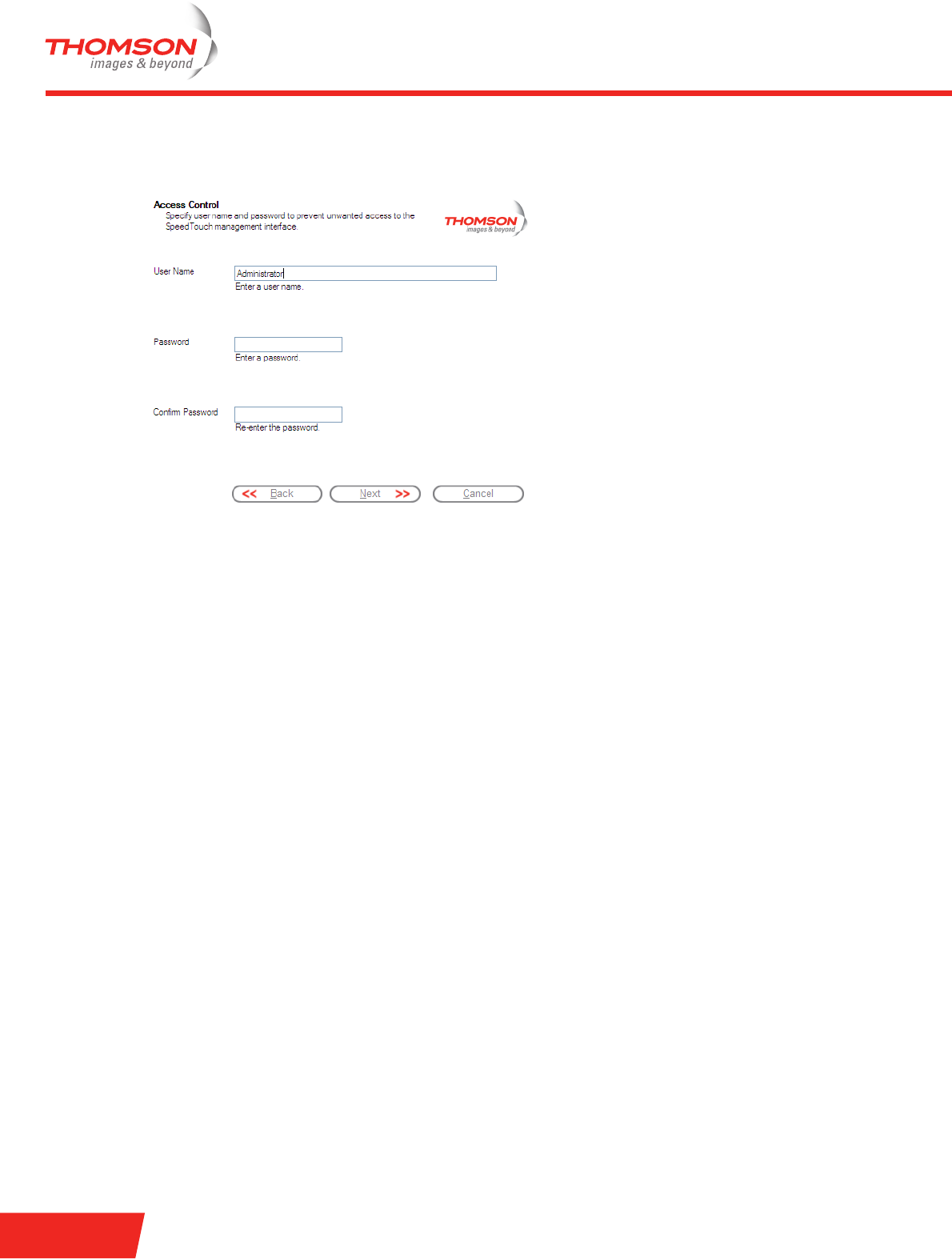
E-DOC-CTC-20060911-0041- v1.0
Chapter 2
Basic Installation
14
3Provide a user name and password to protect your Thomson Gateway from unauthorised access. Each
time a user wants to access a Thomson Gateway management interface, the user will be prompted to
provide this user name and password before access is granted.
Click Next to continue.
4The procedure continues with the final steps of configuring your Thomson Gateway and your computer.
Proceed with “ Finishing the Home Install Wizard” on page 15.
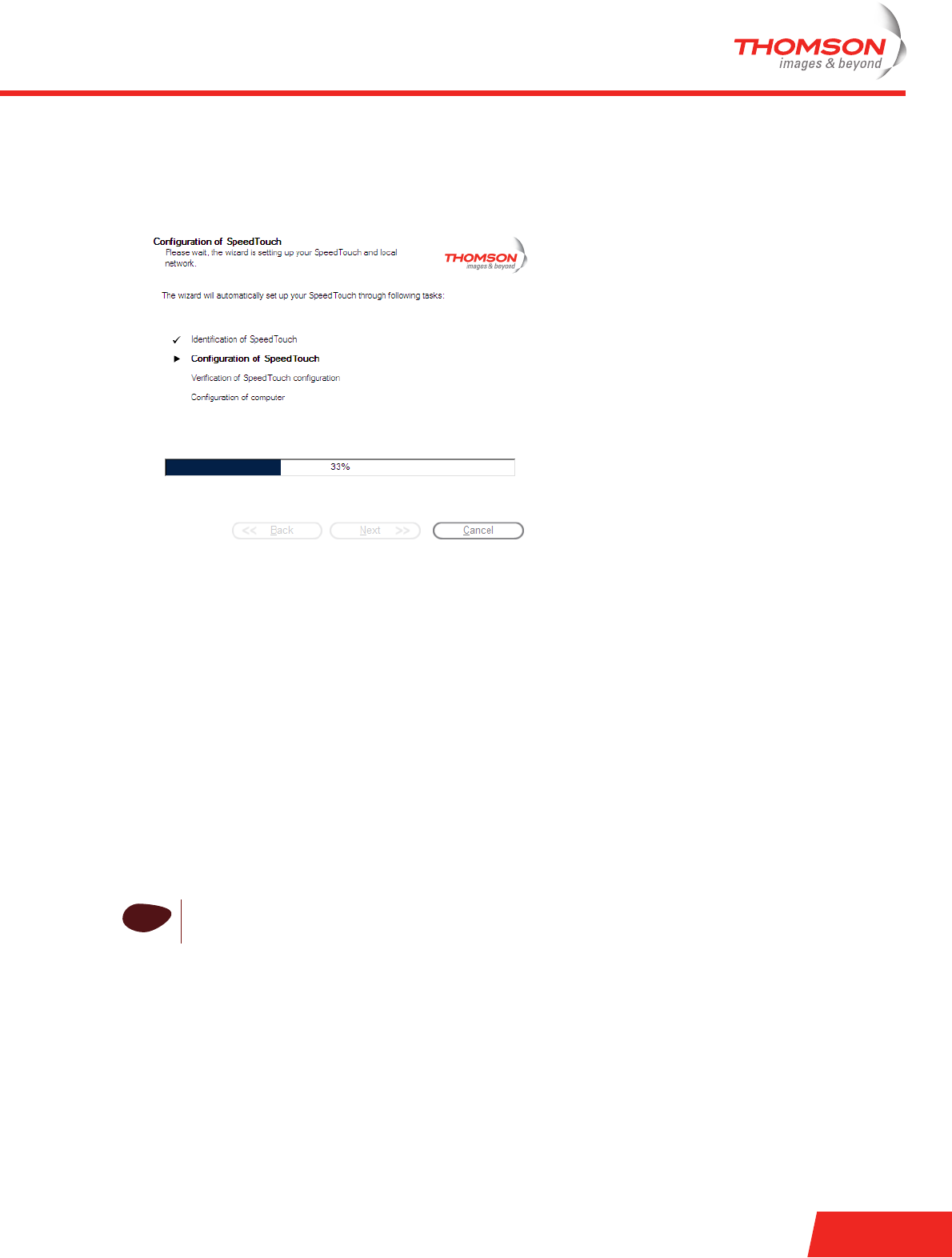
E-DOC-CTC-20060911-0041- v1.0
Chapter 2
Basic Installation
15
Finishing the Home Install Wizard
The Home Install Wizard will configure the Thomson Gateway and your computer according to the service
profile. Proceed as follows:
1You can follow the configuration progress in following window:
2Click Finish to close the wizard.
The following steps will happen automatically:
After some seconds, the Internet LED on your Thomson Gateway will be lit green to indicate Internet
connectivity. If not, refer to “4.2 LED Diagnostics” on page 31. If needed, you can test your Internet
connection as described in “ Testing your Internet Connection” on page 33.
The CD Menu is displayed. See “2.3 The Setup CD” on page 18 for more information.
You are redirected to the embedded Thomson Gateway pages automatically (unless you cleared the
http://dsldevice.lan check box in the last window of the Home Install Wizard). These pages allow you
to configure the Thomson Gateway firewall, Thomson Gateway settings, your wireless access point
settings, and so on. See the User’s Guide for more information.
More on IP settings
In most cases, the computer’s networking interface used during the Home Install Wizard procedure will be
configured for obtaining its IP configuration dynamically. This is the most convenient configuration and
should not be changed.
iFor fixed or advanced IP configurations, please follow the instructions of your ISP.
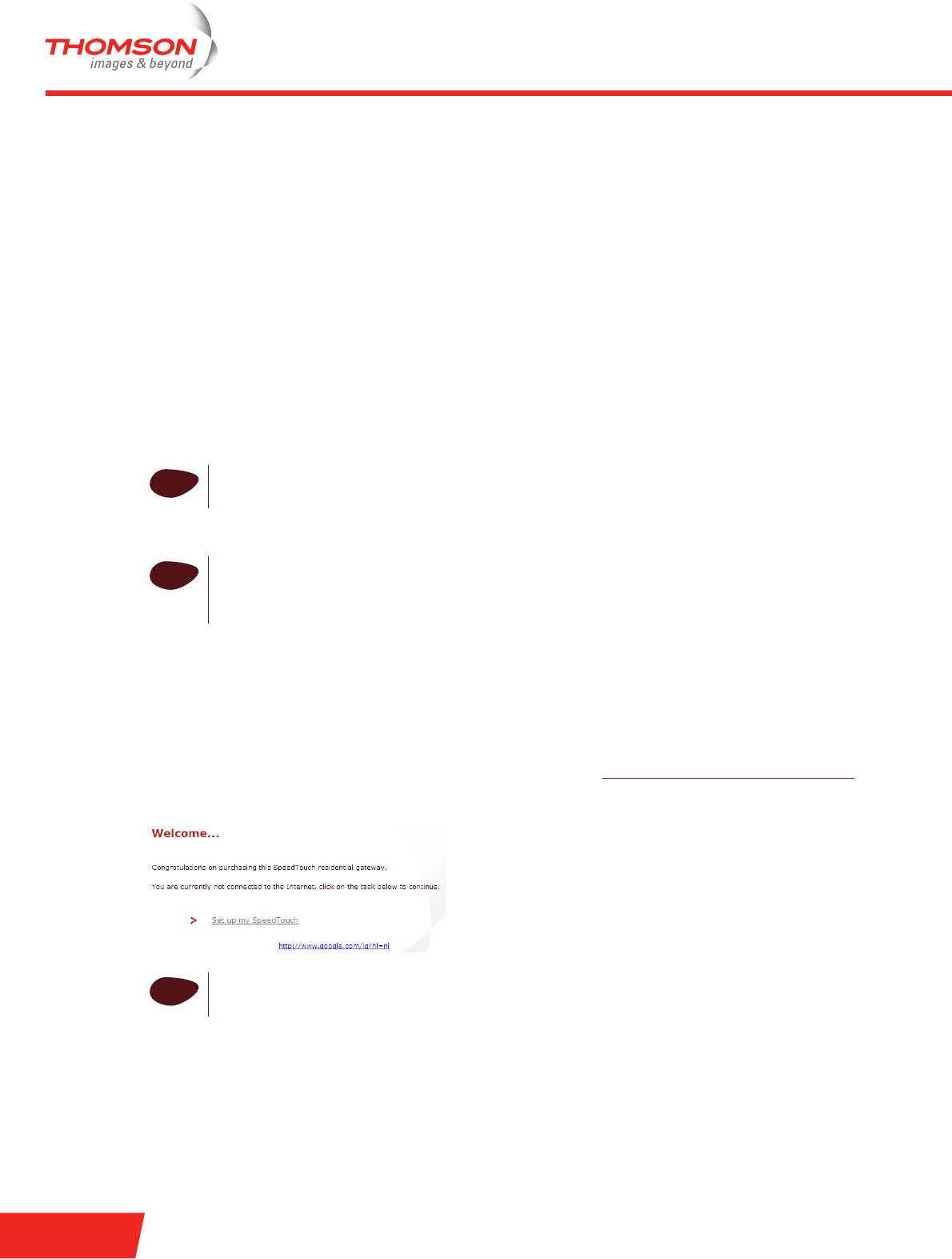
E-DOC-CTC-20060911-0041- v1.0
Chapter 2
Basic Installation
16
2.2.2 Manual Installation
Web-based Easy Setup
With the help of the Easy Setup, your Internet connection is set up in a few clicks.
The Easy Setup is Operating System independent.
Preconditions
Make sure that:
>Your Thomson Gateway is correctly set up and turned on.
>Your computer is connected to the Thomson Gateway. In case of a wireless connection, a wireless client
adapter has to be installed on your computer and correctly configured to connect to your Thomson
Gateway.
>Your host computer is configured as DHCP client or with a valid fixed IP address. For more information,
refer to the Help of your browser.
>Your Web browser is not using a proxy server. For more information, see “ Disable proxy server” on
page 40.
HTTP intercept
Proceed as follows:
1Open a Web browser. Browse to an arbitrary Web site, for instance http://www.thomson-broadband.com.
As long as no Internet connection has been set up, you will be automatically redirected to the Thomson
Gateway Welcome page.
2Click Set up my SpeedTouch to start the Easy Setup wizard.
3Proceed with “ Using Easy Setup” on page 17.
iSee “ Wiring” on page 20 for a comprehensive overview of all Thomson Gateway connections.
iIn case of problems, you can give the host computer a fixed IP address in the same subnet as
your Thomson Gateway (If the Thomson Gateway is in its default settings, that is an address
between 192.168.1.1 and 192.168.1.253). In case you use fixed IP addresses, the Thomson
Gateway has to be configured as DNS server.
iIf you are not redirected automatically, go to “ Starting the Easy Setup wizard” on page 17.
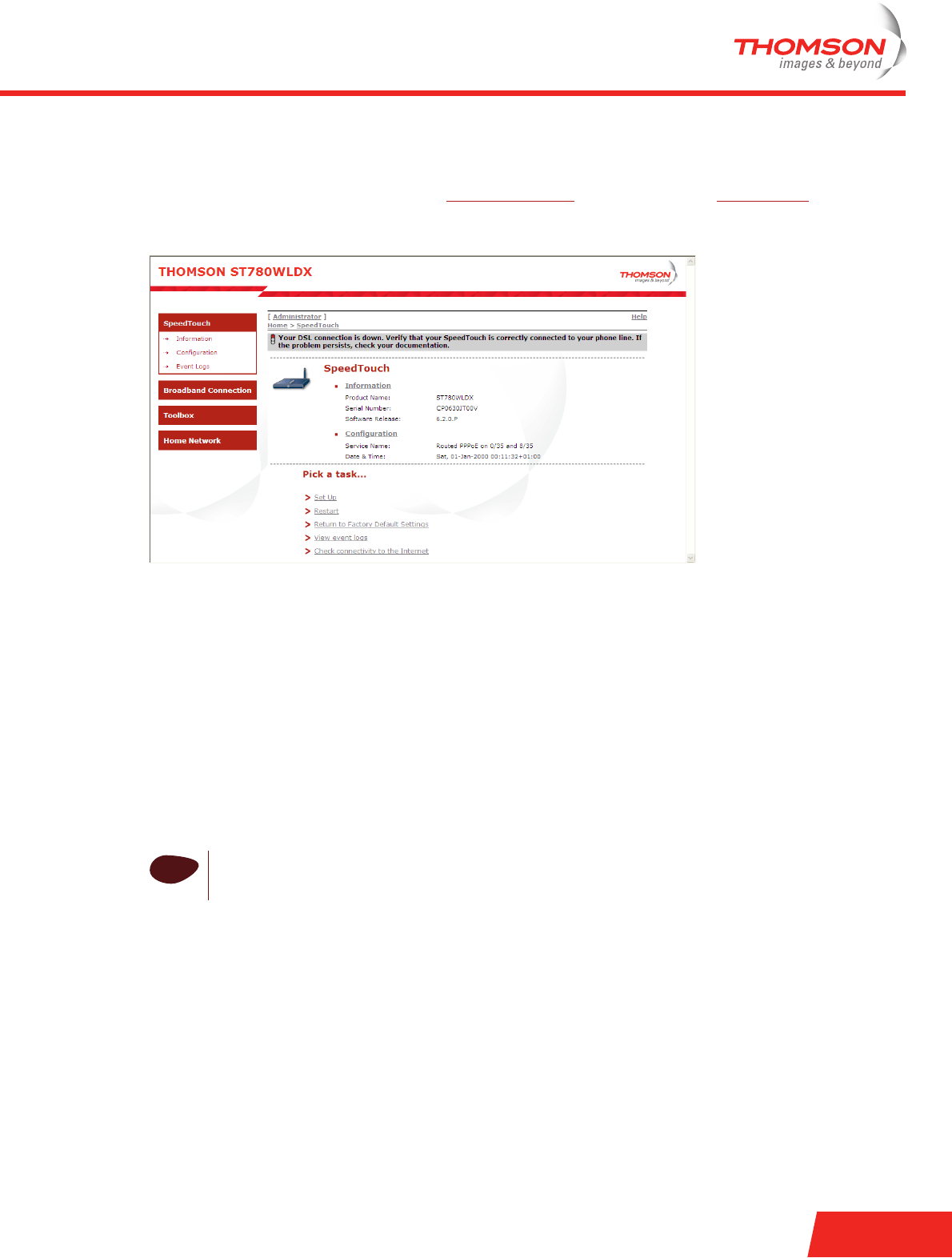
E-DOC-CTC-20060911-0041- v1.0
Chapter 2
Basic Installation
17
Starting the Easy Setup wizard
You can also start the Easy Setup wizard from within the embedded Web pages. Proceed as follows:
1Browse to the Thomson Gateway pages on http://dsldevice.lan or on its IP address, 192.168.1.254 by
default).
2In the menu, click SpeedTouch.
3In the Pick a task list, click Set Up.
Using Easy Setup
In the Easy Setup wizard:
1Click Next to proceed. If for some reason you want to abort the wizard, click Cancel.
2Choose the Service provided by your ISP (Router or Bridge) and click Next.
3Select the appropriate VPI/VCI - and, if required, the Connection Type (PPPoE or PPPoA) - provided by
your ISP, and then click Next.
4For a Routed service, fill in the Internet Account settings (PPP user name and password) provided by your
ISP, and then click Next.
5Fill in a Security user name and Password for your Thomson Gateway.
6In the next window you can review your settings, before starting the configuration of your Thomson
Gateway. If something is missing or incorrect, click Back. To confirm your settings, click Start.
7Wait until the configuration is finished, and then click Finish.
iThe factory default user is ‘Administrator’ and its password is blank. It is advisable to specify
another Administrator user name and password to protect your Thomson Gateway from
security violation, as described in “2.6 Basic Security” on page 24.
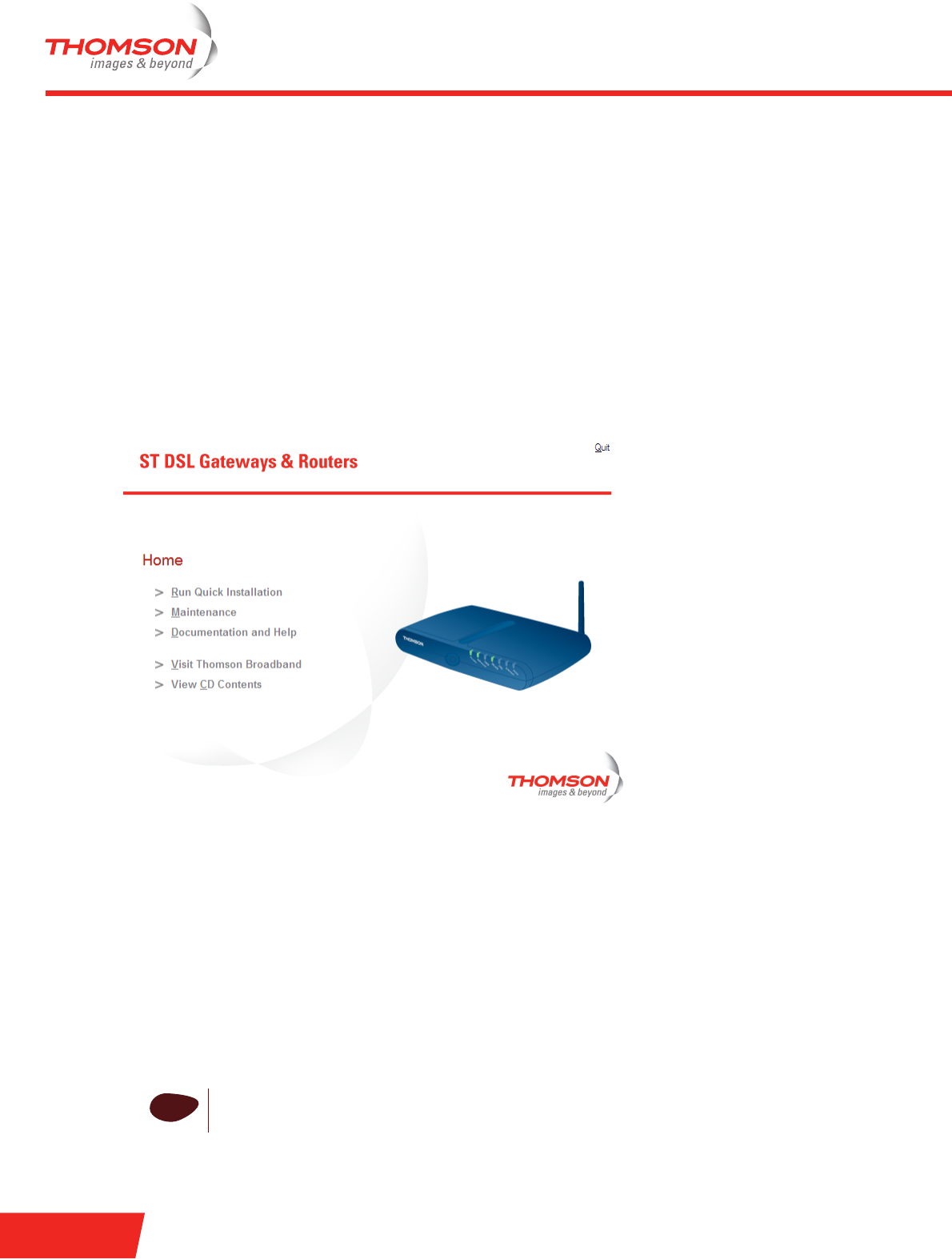
E-DOC-CTC-20060911-0041- v1.0
Chapter 2
Basic Installation
18
2.3 The Setup CD
Setup CD
Your Thomson Gateway comes with a Setup CD. If you insert the Setup CD into a Microsoft Windows PC or
Mac OS X computer, an intuitive CD Menu guides you through the features and contents of the Setup CD and
allows you to easily browse for user documentation, Thomson Gateway system software, service templates,
etc.
CD menu
The CD menu appears automatically each time you insert the CD, or after running the Quick-Install Wizard
and subsequent Home Install Wizard:
Select:
>Run Quick Installation to start the Quick-Install Wizard and Home Install Wizard.
>Maintenance to:
Reconfigure your Thomson Gateway via the Home Install Wizard.
Check for software upgrades.
>Documentation and Help to:
Consult user documentation for your Thomson Gateway.
Consult user documentation for Thomson networking products.
See more information on Thomson products and solutions.
If you connect to the Internet, the document list will automatically be updated with the latest
documentation.
iIf you have problems viewing the documentation, see “ I cannot view the Thomson Gateway
documentation” on page 36.
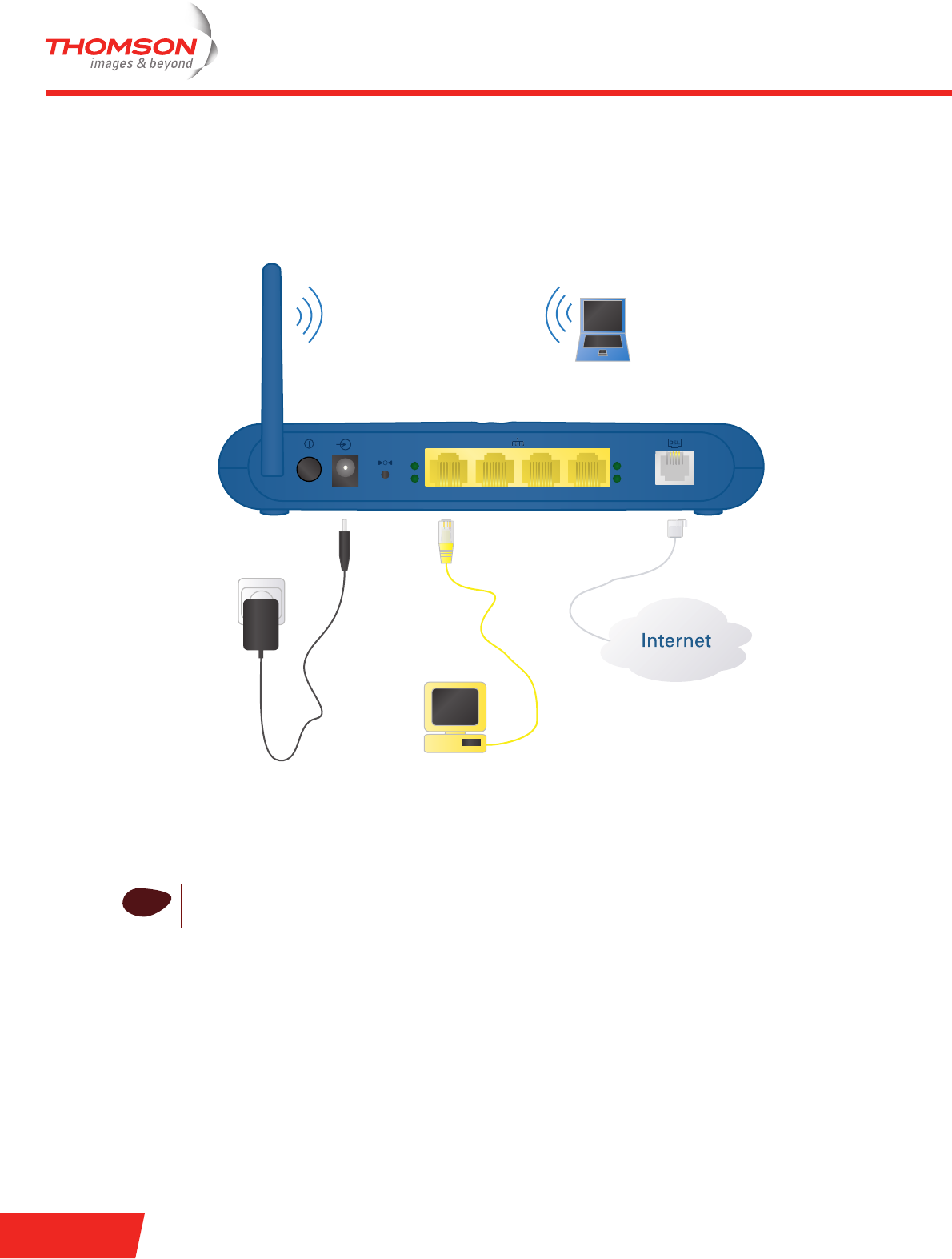
E-DOC-CTC-20060911-0041- v1.0
Chapter 2
Basic Installation
20
2.4 Thomson Gateway Connection Essentials
Wiring
The image below shows all possible types of connection to the Thomson Gateway.
Making connections
In most cases, the Quick-Install Wizard and Home Install Wizard will guide you through the process of making
all the required connections to your Thomson Gateway.
If you want to make the required connections yourself, see “2.5 Connections Overview and Powering” on
page 21 for more information.
Ethernet
1432
DSLReset
1
2
4
3
ON/OFF
iIt is recommended to wait to make any of these connections until the wizard prompts you to do so.
See “2.2 Installing your Thomson Gateway” on page 7 for more information.

E-DOC-CTC-20060911-0041- v1.0
Chapter 2
Basic Installation
21
2.5 Connections Overview and Powering
Introduction
If you want to make the required connections yourself without using the guided installation procedure as
recommended, you must:
>Read the safety instructions and regulatory notices first.
>Follow the order as indicated below.
DSL connection
Use the grey DSL cable to connect the Thomson Gateway DSL port to your telephone wall outlet or
distributed filter.
Powering the Thomson Gateway
Plug the coaxial jack of the electric power supply adapter into the Thomson Gateway power inlet port and the
other end into the wall outlet.
To turn on the Thomson Gateway, press the power button on the Thomson Gateway rear panel.
During the start-up procedure, the power LED on the front panel is lit red for some seconds. As soon as the
power LED is solidly lit green, your Thomson Gateway is ready for service. After another couple of seconds,
also the DSL LED will light green.
If these LEDs do not light, please refer to ”Checking the LEDs” on page 31. A comprehensive LED overview
can be found in the User’s Guide.
Use the same button to turn off your Thomson Gateway.
Network connections
Your Thomson Gateway allows you to connect your computer(s) via:
>Ethernet
>Wireless networking
iYou can find the safety instructions on the Setup CD (see “2.2 Installing your Thomson
Gateway” on page 7). They may also be provided as a printed booklet.
iThe Thomson Gateway electrical power requirements are indicated on the label on the bottom side
of your Thomson Gateway. In case you need to use another power supply than the one provided,
make sure that the spare supply complies with the Thomson Gateway power requirements.

E-DOC-CTC-20060911-0041- v1.0
Chapter 2
Basic Installation
22
2.5.1 Wireless Setup
Wireless client adapters
If you want a wireless connection to your Wi-Fi certified Thomson Gateway, you need a wireless 802.11 b/g
compatible client adapter.
You can use one of the following wireless client adapters:
>Thomson ST110g CardBus
>Thomson ST121g USB adapter
>Thomson ST122g USB adapter
>Any other Wi-Fi certified WLAN client
>A built-in Wi-Fi certified WLAN adapter, if present in you computer
iTo install hardware on a Microsoft Windows 2000 or a Microsoft Windows XP operating system,
you need administrative rights on your computer.
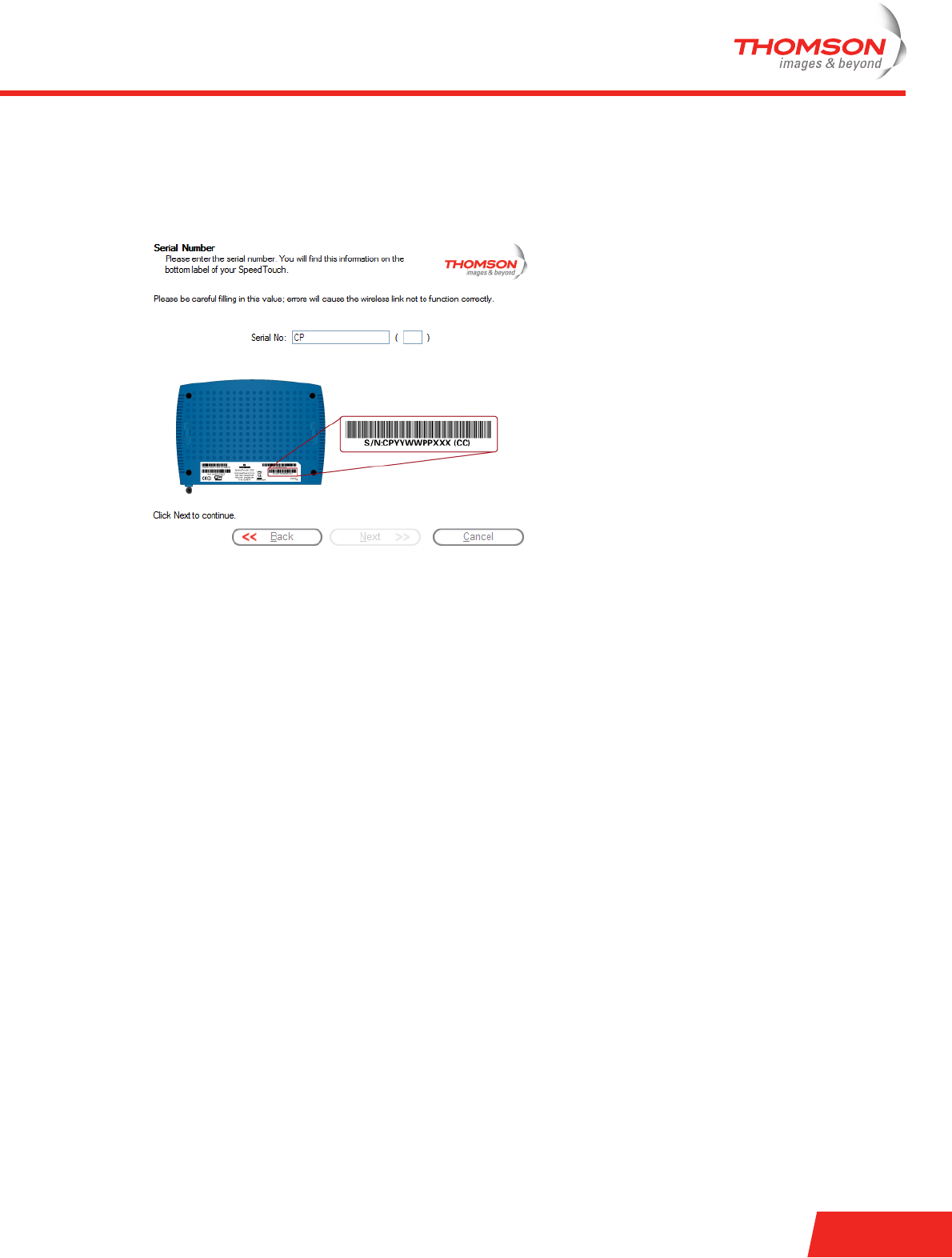
E-DOC-CTC-20060911-0041- v1.0
Chapter 2
Basic Installation
23
Installing your wireless client adapter
Proceed as follows when the Home Install Wizard prompts you to plug in the wireless client adapter:
1Plug in the wireless client adapter. The hardware is being installed.
2Enter your Thomson Gateway’s serial number and click Next.
A progress window appears, showing the setup of the wireless connection to your Thomson Gateway.
3Continue with ”Configuring the Internet connection” on page 12.

E-DOC-CTC-20060911-0041- v1.0
Chapter 2
Basic Installation
24
2.6 Basic Security
Default user name and password
The Thomson Gateway comes with a default user. Its user name is ‘Administrator’ and the default password
is blank.
Changing your password
For security reasons, it is recommended to set a password to access the Thomson Gateway. Proceed as
follows:
1Go to the Thomson Gateway home page (http://dsldevice.lan or 192.168.1.254).
2In the left pane, choose Toolbox > User Management.
3In the Pick a task list, click Change my password.
4Enter a new password and confirm.
Default wireless security settings
Also for wireless connections to your Thomson Gateway, by default there are no security settings, so the
Thomson Gateway is initially accessible to all wireless devices:
>The Network Name (SSID) is broadcast.
>The security level is initially set to Low (that is: no encryption is used).
>The Access Control List (ACL) is open and empty. New stations are automatically allowed to access the
Thomson Gateway.
It is recommended to change these Thomson Gateway wireless access point settings either automatically via
the Thomson Gateway Home Install Wizard, either manually as described in the Thomson Gateway User’s
Guide.
Securing your wireless network
To secure your wireless network, you can:
>Allow or deny access based on the MAC address of the wireless client(s). Known MAC addresses are kept
in the Access Control List (ACL). If the Thomson Gateway is configured to allow new stations via
registration, unknown computers will have to register before they can connect.
>Turn off the broadcast of the wireless Network Name (SSID). New wireless clients that are scanning for
available networks will not see your network appear in their list.
iDo not forget this logon information or you will be forced to reset the Thomson Gateway back
to its default configuration.
iFor the ACL you have the following options:
>Allowed (automatically): All new stations can access the Thomson Gateway.
>Allowed (via registration): Only allowed stations in the ACL have access. You can add new
stations via the Association / Registration button.
>Not allowed: Only allowed stations in the ACL have access.

E-DOC-CTC-20060911-0041- v1.0
Chapter 2
Basic Installation
25
>Encrypt the data that will be sent over the wireless network. You can choose different encryption methods
or levels of security:
High: Wi-Fi Protected Access Pre-Shared Key (WPA-PSK) encryption, the highest form of security
available. This can only be used if your wireless client and client manager support it.
Medium: Wired-Equivalent Privacy (WEP) encryption.
Low: no encryption, no security.
iFor more information, see the Thomson Gateway User’s Guide.

E-DOC-CTC-20060911-0041- v1.0
Chapter 2
Basic Installation
26

E-DOC-CTC-20060911-0041- v1.0
Chapter 3
Web-Based User Interface
27
3 Web-Based User Interface
Embedded pages
The Thomson Gateway comes with embedded web pages, providing an interface to the software installed on
the device. It allows Easy Setup and management of the Thomson Gateway via your web browser from any
computer connected to the Thomson Gateway.
Access
Proceed as follows to access the pages:
1Open your Web browser.
2In the address bar, type http://dsldevice.lan or your Thomson Gateway’s IP address (the default IP address
is 192.168.1.254) and press ENTER.
3Enter your Thomson Gateway security user name and password.
4The Thomson Gateway’s home page will be displayed in your browser. From here - depending on the
rights of your user account - you have access to the other pages.
Tasks
Among others, you can:
>View the Thomson Gateway’s current settings and status.
>Configure the Thomson Gateway to connect to your Service Provider with the settings provided.
>Set the Thomson Gateway’s firewall to work with specific applications.
>Set up security features.
>Enable remote management access.
>Back up your configuration settings.
>Reset the Thomson Gateway’s default settings.
Using the Web pages
When making changes to the Thomson Gateway configuration via the Web pages, the configuration is stored
automatically whenever you click Apply.
For more information on the embedded pages, refer to the Help in the upper right corner of the notification
and navigation area or refer to the Thomson Gateway User’s Guide.
iThe default user name is ‘Administrator’ and the default password is
blank.
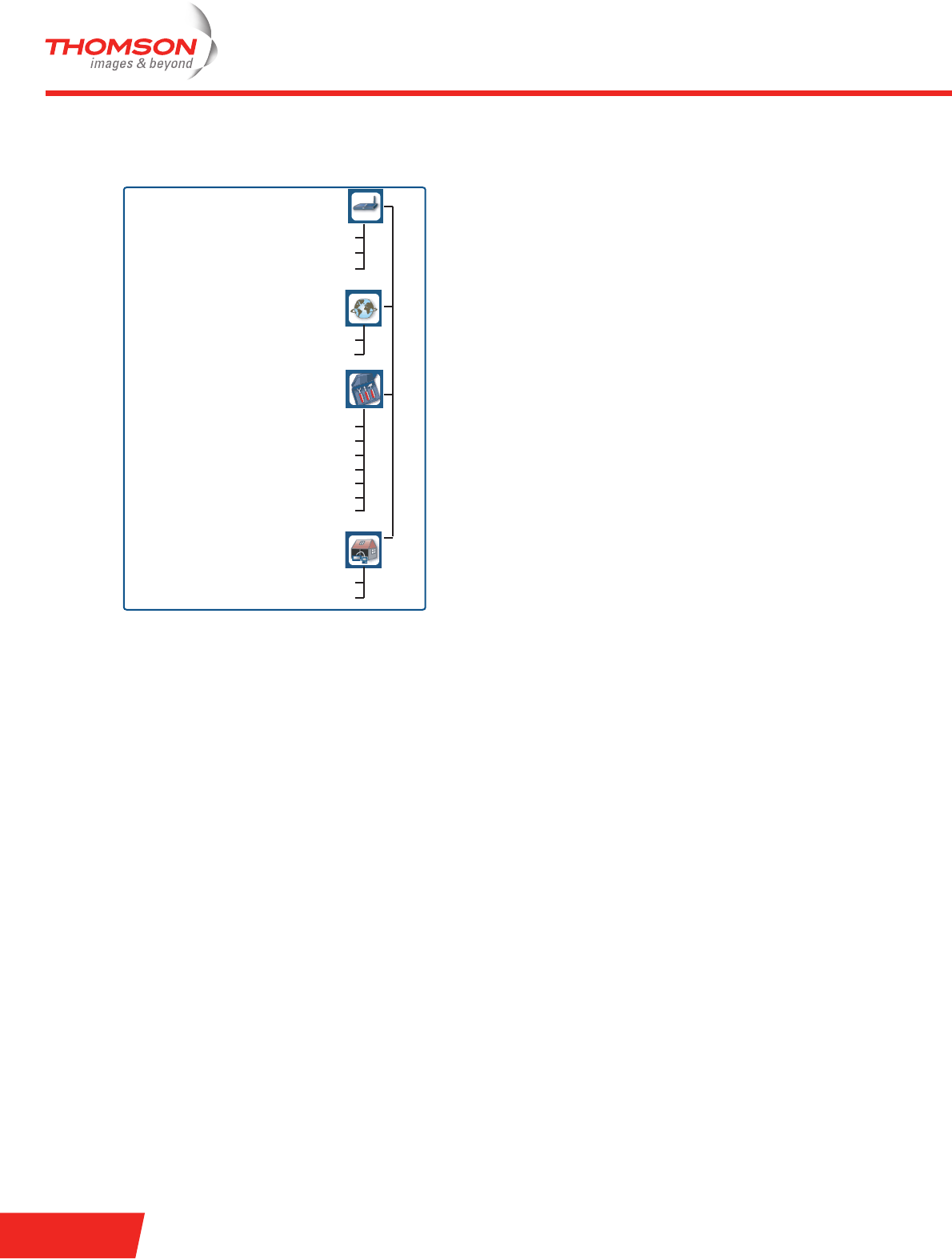
E-DOC-CTC-20060911-0041- v1.0
Chapter 3
Web-Based User Interface
28
Site Map
The following Site Map gives you an overview of the main pages:
Toolbox
Firewall
Home Network
SpeedTouch
Broadband Connection
Information
Configuration
Event Logs
DSL Connection
Internet Services
Remote Assistance
Parental Control
Intrusion Detection
Dynamic DNS
User Management
Game & Application Sharing
Devices
Interfaces

E-DOC-CTC-20060911-0041- v1.0
Chapter 4
Troubleshooting
29
4 Troubleshooting
What to check
The first things to check if you cannot access the Internet, are:
>Power
>Hardware connections
>LEDs
Configuration problems
If your Thomson Gateway is unreachable due to misconfiguration, you might consider a hardware reset to
factory defaults as described in “4.7 Reset to Factory Defaults” on page 41.
If the suggestions in this chapter do not resolve the Internet connection problem, please contact your Internet
Service Provider.
!However, note that resetting the Thomson Gateway to its factory settings will revoke all the
changes you made to the configuration.

E-DOC-CTC-20060911-0041- v1.0
Chapter 4
Troubleshooting
30
4.1 Checking the Hardware
Check the wiring
Plug in properly all the cables you need. Make sure that the cables between your Thomson Gateway,
computers and telephone socket are plugged in firmly. Loose connections can affect your Internet
connection.
Damaged cables can interfere with your Internet connection. Check for damage along the cables and loose
connections at the end of the cable. Replace any damaged cables.
Test the telephone line
To eliminate the possibility of a fault with the telephone line itself, check for a dialling tone by using a
telephone connected to the telephone master socket.
If you are using ADSL, check whether a splitter has been installed or that micro-filters have been correctly
fitted.
Contact your telephone company if there is no dialling tone.
Restart your computer
Loss of Internet or network connectivity may be caused by the computer. Restarting your computer may
solve the problem.
Power-cycle the Thomson Gateway
To restart your Thomson Gateway, simply turn it off. Wait five seconds and turn it back on.

E-DOC-CTC-20060911-0041- v1.0
Chapter 4
Troubleshooting
31
4.2 LED Diagnostics
Checking the LEDs
After establishing a connection with the Internet, at least the following LEDs should solidly light green:
Power, DSL, Internet.
LED status Possible solutions
No LEDs are lit The Thomson Gateway is not turned on, or turned off.
>Make sure the Thomson Gateway is plugged into an electrical outlet.
>Make sure you are using the correct power supply for your Thomson
Gateway. The Thomson Gateway electrical power requirements are
indicated on the label on the bottom of your Thomson Gateway.
>Make sure the Thomson Gateway is turned on.
>Unplug the Thomson Gateway, restart your computer and then plug the
Thomson Gateway back in.
Power LED is lit red or
flashing amber
The Thomson Gateway is malfunctioning or not able to start up.
>Fully unplug the Thomson Gateway from your computer and disconnect
it from its power supply. Wait five seconds, connect the Thomson
Gateway again and turn it back on.
DSL LED is flashing green
or no DSL LED
Your DSL service is unable to synchronise.
>Make sure the Thomson Gateway is plugged into the DSL-enabled phone
line.
>Make sure micro-filters are correctly fitted (if not, it is very likely that your
regular telephone service is not working properly).
>Make sure you have the correct Thomson Gateway variant (ISDN or
POTS) according the DSL/phone service provided to your premises.
>If you have previously had a working connection, call your ISP to check
for service outages.
No Ethernet LED
No Ethernet port’s Link
Integrity/Activity LED
No Ethernet connectivity:
>Make sure the Ethernet cable(s) are firmly connected to the 10/100Base-T
port.
>Make sure you are using the correct cable type for your Ethernet
equipment.
>Make sure the Ethernet NIC driver is correctly installed and enabled on
your computer. Power safe options for the Ethernet NIC should preferably
be disabled.

E-DOC-CTC-20060911-0041- v1.0
Chapter 4
Troubleshooting
32
You can find a comprehensive LED overview in the User’s Guide.
WLAN LED is flashing or
not lit
>The WLAN LED flashes if there is wireless LAN activity and can have
different colours:
Green: The Thomson Gateway wireless access point is operating in
the highest security mode (WPA). Make sure to use the same WPA
encryption on the WLAN client.
Amber: The Thomson Gateway wireless access point is operating in
medium security mode (WEP). Make sure to use the same WEP
encryption on the WLAN client.
Red: The Thomson Gateway wireless access point uses no security.
>The WLAN LED is not lit if the Thomson Gateway wireless access point is
disabled. For wireless networking, make sure the WLAN is enabled on the
Thomson Gateway. Proceed as follows:
1Go to the Thomson Gateway Web pages.
2In the menu select Home Network > Interfaces.
3Click WLAN.
4Click Configure.
5Select Interface Enabled.
- OR -
1Press and hold the Association / Registration button until the WLAN
LED is lit (green, amber or red).
2The WLAN LED is toggling between red and green: If new stations are
only allowed via registration and if you pressed the Association /
Registration button, the ACL will be unlocked for 30 seconds during
which you can connect new wireless clients.
Red Internet LED or No
Internet LED
>There was an authentication failure. This will usually present itself as an
error message regarding an incorrect password.
Check whether your user name is correct. For ADSL connections, the
user name is normally in the form of username@ISP.
Check whether your password is correctly entered. The password is
case sensitive.
If you continue to get password failures, contact your ISP.
>The wrong service profile was selected. Restart the setup of your
Thomson Gateway, and make sure to select the correct service profile.
LED status Possible solutions
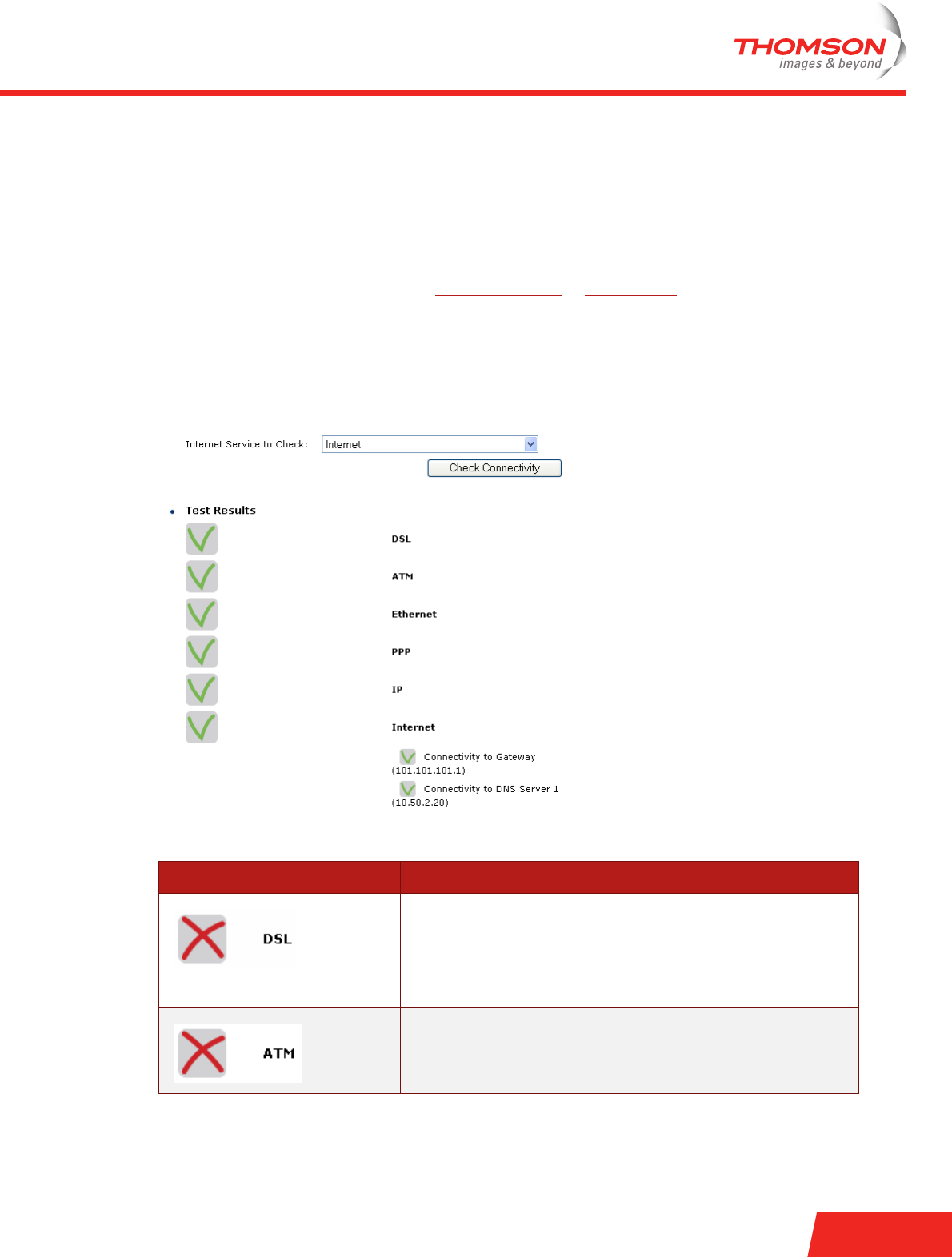
E-DOC-CTC-20060911-0041- v1.0
Chapter 4
Troubleshooting
33
4.3 Web Diagnostics
Testing your Internet Connection
After setting up the Internet connection, there is an easy way to check whether your configuration is fine.
Proceed as follows:
1Go to the Thomson Gateway home page (http://dsldevice.lan or 192.168.1.254).
2In the menu, click SpeedTouch.
3In the Pick a task list, click Check connectivity to the Internet.
4In the Internet Service to Check box, select the Internet service you want to check.
5Click Check Connectivity.
If the test is successful, you will see a list of green check marks as shown in the example below:
Otherwise a red cross will help you to diagnose the problem:
Test result Explanation
Your DSL line is not synchronised.
>Check whether your telephone line is correctly connected to
your Thomson Gateway.
>Check the DSL LED, as described in “ Checking the LEDs” on
page 31.
No ATM activity detected on your DSL line.
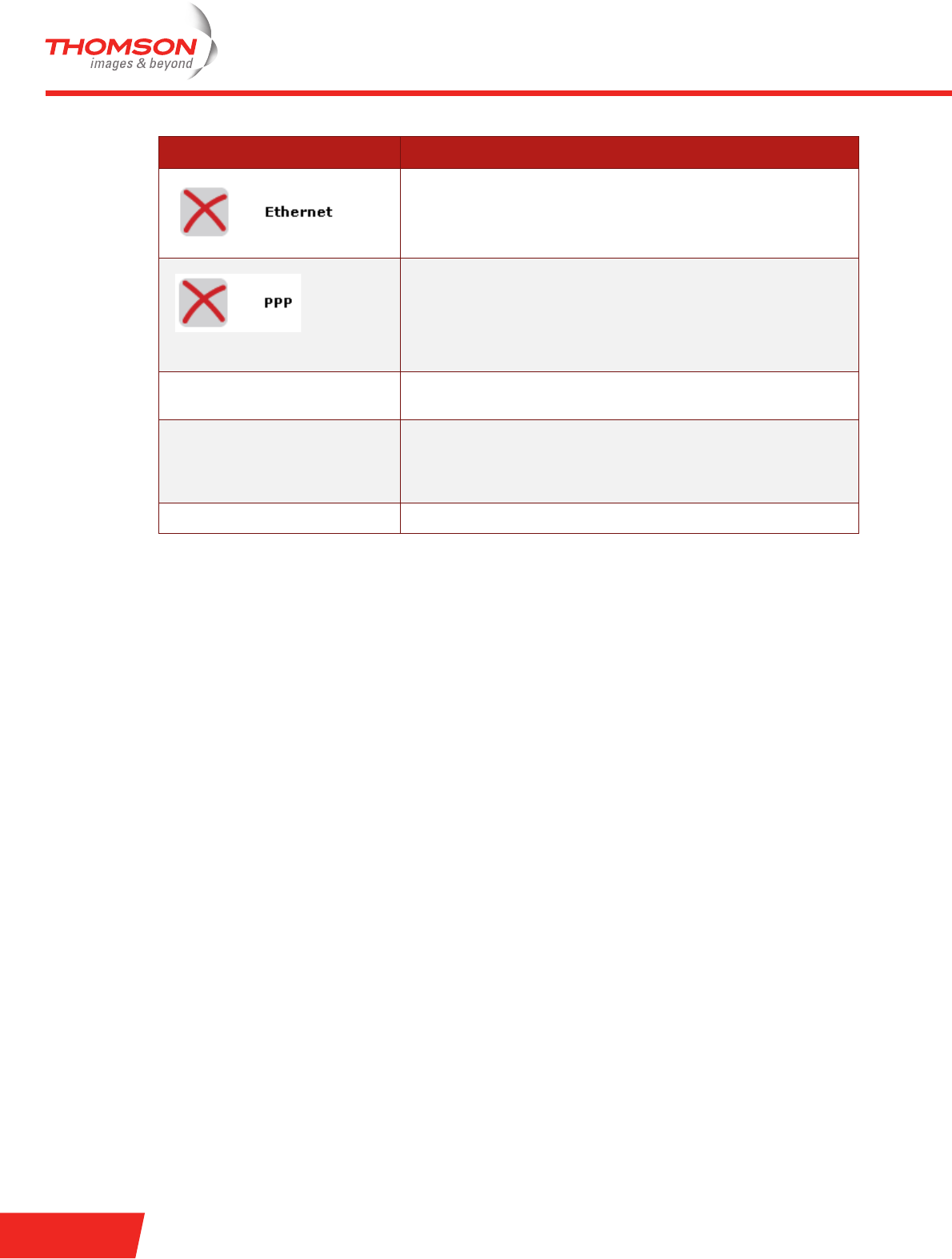
E-DOC-CTC-20060911-0041- v1.0
Chapter 4
Troubleshooting
34
No Ethernet activity.
If you are connected through a protocol other than PPPoE, this
check is not applicable as the result will always be ‘No Ethernet
activity’.
>Authentication failed: check your user name and password.
The user name is in most cases in the form of
username@ISP.
>Your connection is disconnected.
>Could not bring up link.
No IP No IP address or no DNS server has been configured. During IP
address negotiation, there was an IPCP error or a DHCP error.
No Internet This test sends 1 ping to each address of a configured list of IP
addresses. The test succeeds if all addresses can be reached. If
your primary and secondary DNS server are part of the list,
reaching one of both is enough.
No DNS The DNS service provided by your ISP may have a problem.
Test result Explanation
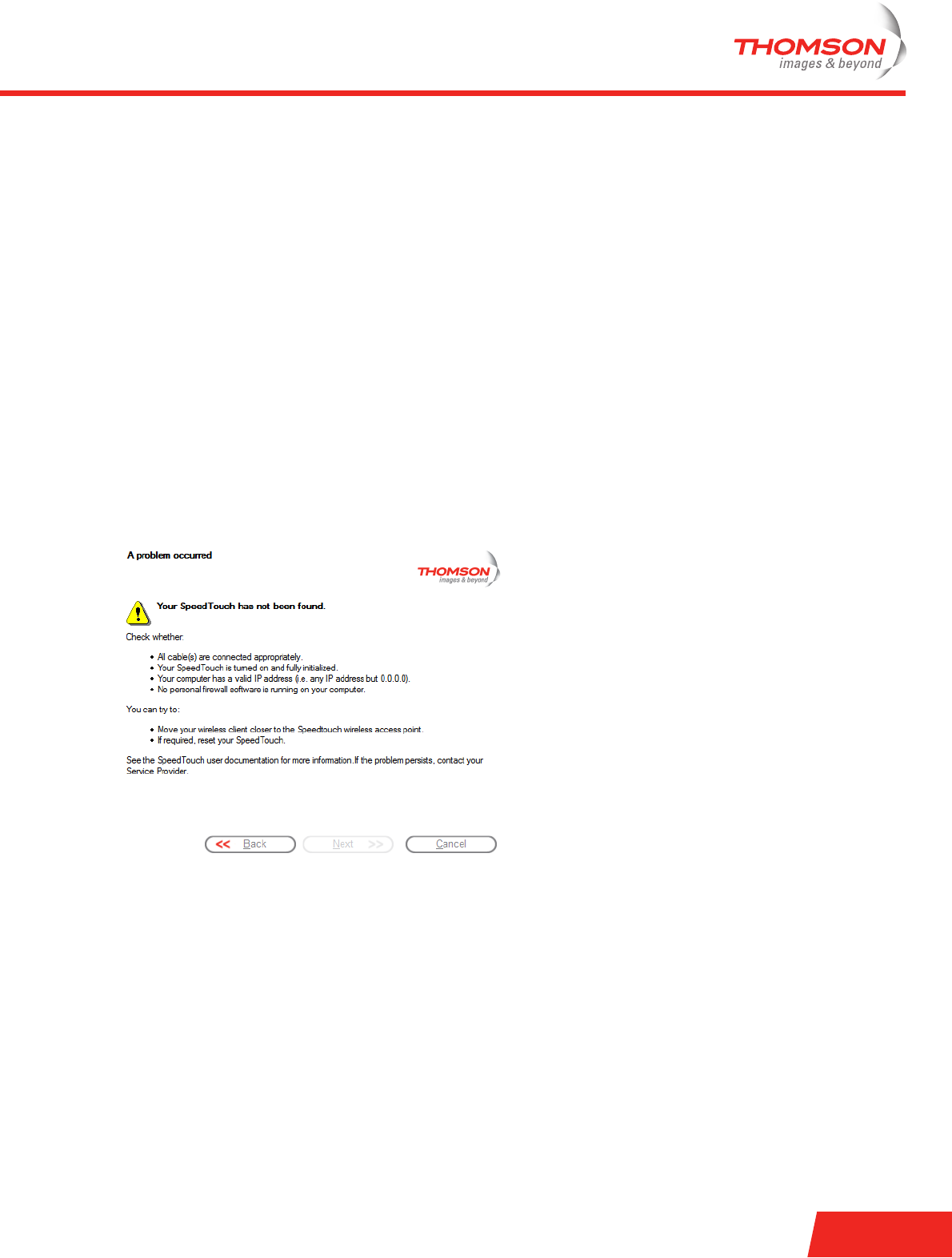
E-DOC-CTC-20060911-0041- v1.0
Chapter 4
Troubleshooting
35
4.4 Thomson Gateway Setup CD Troubleshooting
The Thomson Gateway CD does not start automatically
Proceed as follows:
>In Microsoft Windows:
1In the Windows task bar, click the Start button.
2Select Run.
3In the Open field, enter the following path: D:\Setup.exe, where D stands for the drive letter of your
CD-ROM drive.
>In Mac OS X:
1On your desktop, double-click the CD icon.
2Double-click Menu.
The wizard does not detect a connection
If the Home Install Wizard does not detect a connection to your Thomson Gateway, an error window appears.
If this is the case, check whether:
>The Thomson Gateway is turned on and fully initialised.
>Your computer has a valid IP address, that is any address but 0.0.0.0.
In Microsoft Windows:
1In the taskbar, click the Start button.
2Select Run.
3In the Open field, type cmd.
4Click OK.
A black window will appear with a flashing cursor.
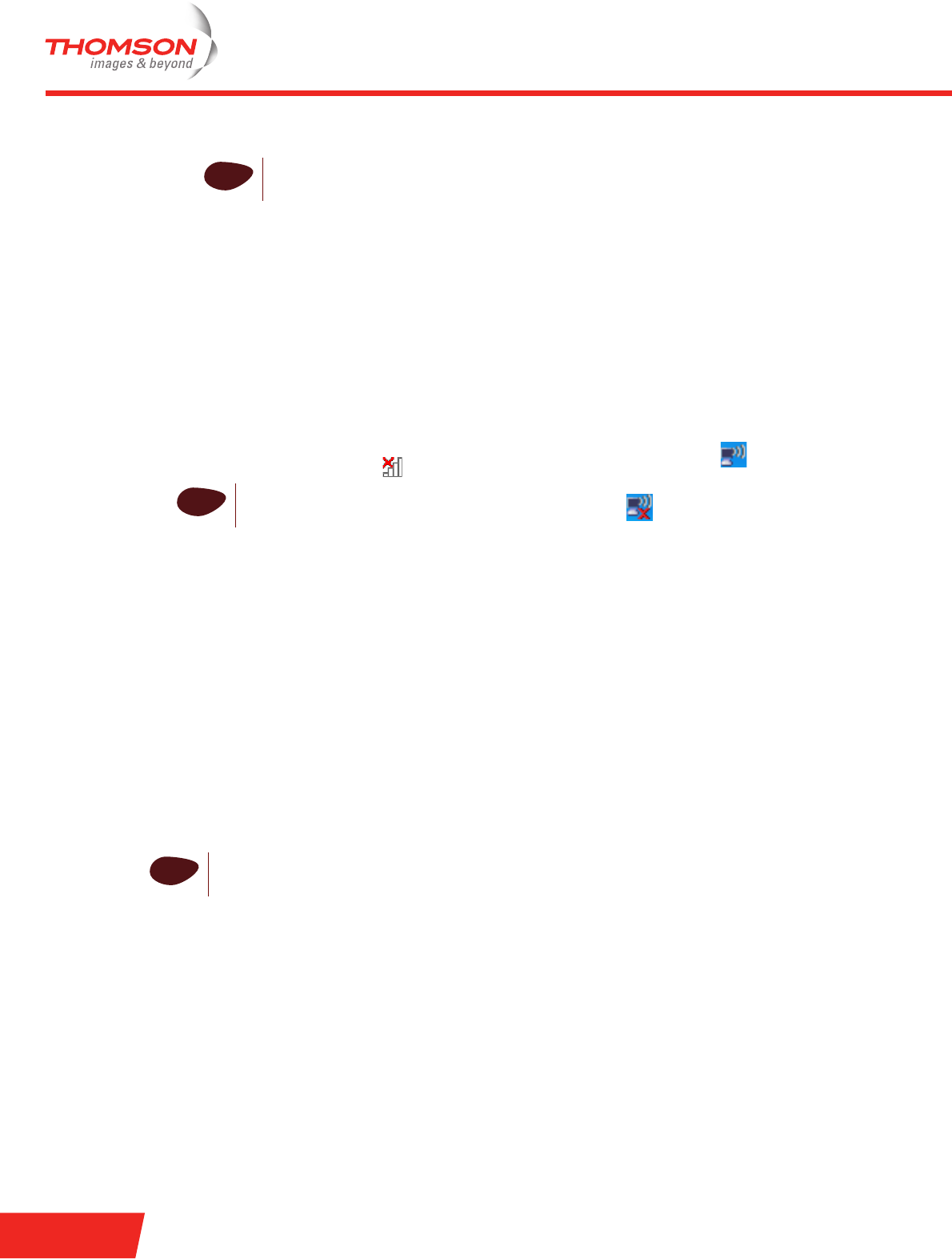
E-DOC-CTC-20060911-0041- v1.0
Chapter 4
Troubleshooting
36
5Type ipconfig /all and press ENTER.
Your IP address is displayed.
In Mac OS X:
1Go to Dock > System Preferences.
2Click Network.
3Click the TCP/IP tab.
Your IP address is displayed.
>No dedicated firewall device or router is placed between your computer and the Thomson Gateway.
>No personal network security software (for example firewall software) is running on your computer.
>Your computer is correctly connected to the Thomson Gateway, or the WLAN client is correctly
associated with the Thomson Gateway.
1In the Windows XP notification area, click the Wireless Network Connection icon or the Thomson
Gateway Client Manager icon .
2Check whether the displayed network has your Thomson Gateway network name (SSID).
To repeat the search for your Thomson Gateway, click Back or restart the wizard. As soon as the wizard finds
your Thomson Gateway, you can continue with “ Configuring the Thomson Gateway (and your computer)”
on page 13.
The Thomson Gateway is not responding
If the completion window does not appear after running the Thomson Gateway Home Install Wizard, this
means that the Thomson Gateway is not responding or not accessible anymore.
There are two possibilities:
>This might be due to the reconfiguration of the Thomson Gateway’s IP settings or wireless access point
settings. In this case, the last window of the Home Install Wizard will not be shown. Your Thomson
Gateway is correctly set up though and you will be able to surf the Internet.
>If you did not reconfigure the Thomson Gateway’s IP settings or wireless access point settings, restart the
Home Install Wizard.
If the problem persists, refer to the Service Provider’s instructions for more information.
I cannot view the Thomson Gateway documentation
To be able to view the Thomson Gateway documentation pages on the Setup CD, JavaScript must be enabled
in your Web browser. For more information, refer to the Help of your Web browser.
To allow active content on a Microsoft Windows XP system, see “ I get a warning about active content in
Internet Explorer” on page 37.
iIn Microsoft Windows 98 or Microsoft Windows Millennium, type winipcfg and then
press ENTER.
iIf you are not connected, this icon will have a red cross:
iIf the setup fails over a wireless connection, try to set up your Thomson Gateway using a wired
connection.
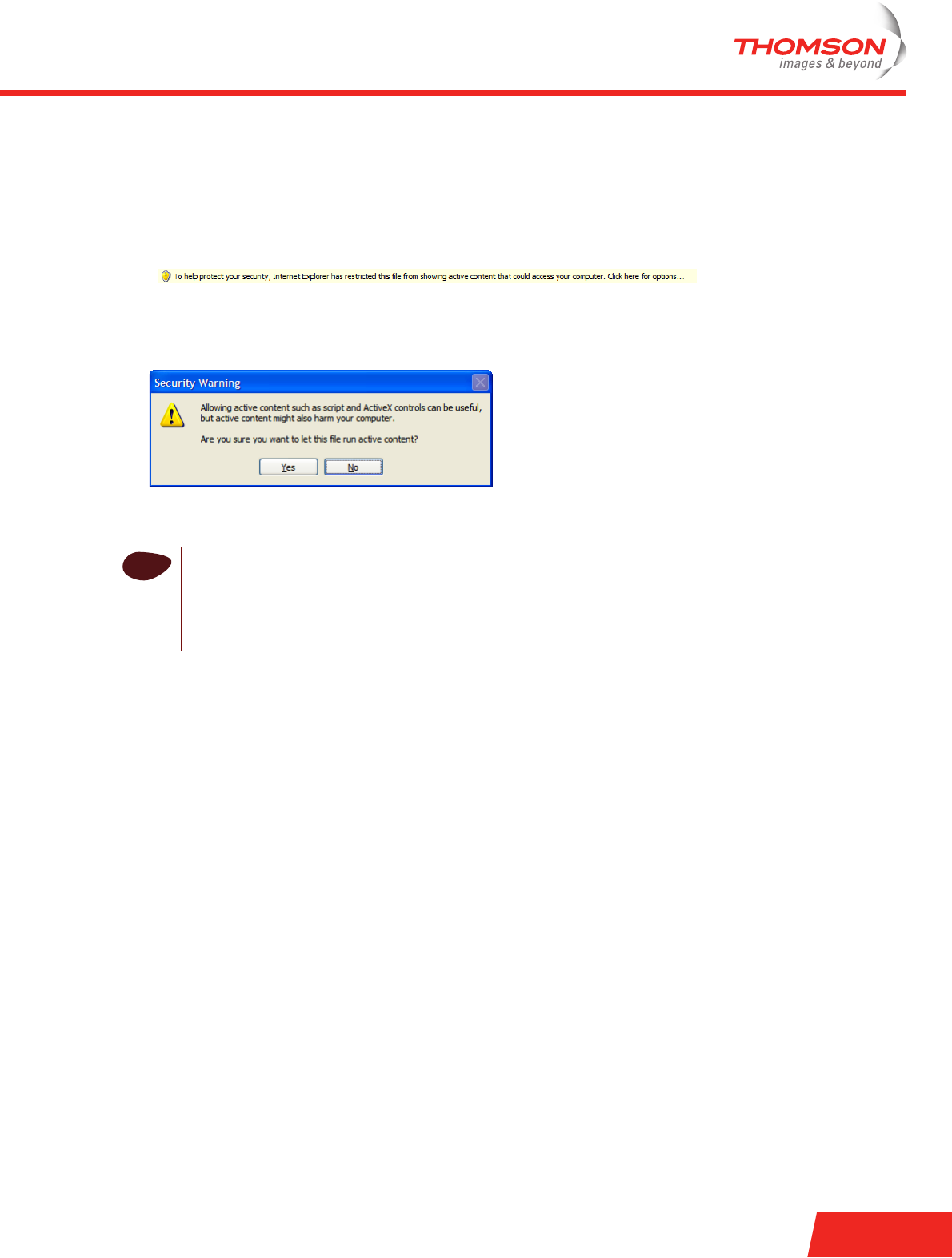
E-DOC-CTC-20060911-0041- v1.0
Chapter 4
Troubleshooting
37
I get a warning about active content in Internet Explorer
When opening documentation pages from the Setup CD, a warning might be displayed. This may be the case
when the pages are opened in Internet Explorer and you are using Microsoft Windows XP with Service Pack
2.
Proceed as follows to view the documentation:
1In Internet Explorer, the following message will appear in the Information Bar:
2Click the Information Bar (with the warning).
3Select Allow Blocked Content.
A security warning is displayed:
4Click Yes.
You can now view or print the Thomson Gateway documentation pages.
iThis warning will be displayed every time you consult the documentation. If you do not want this
message to be shown in the future, you must allow CDs to run active content on your computer:
1In the Internet Explorer menu, select Tools > Internet Options.
2Click the Advanced tab.
3Under Security, select Allow active content from CDs to run on My Computer.
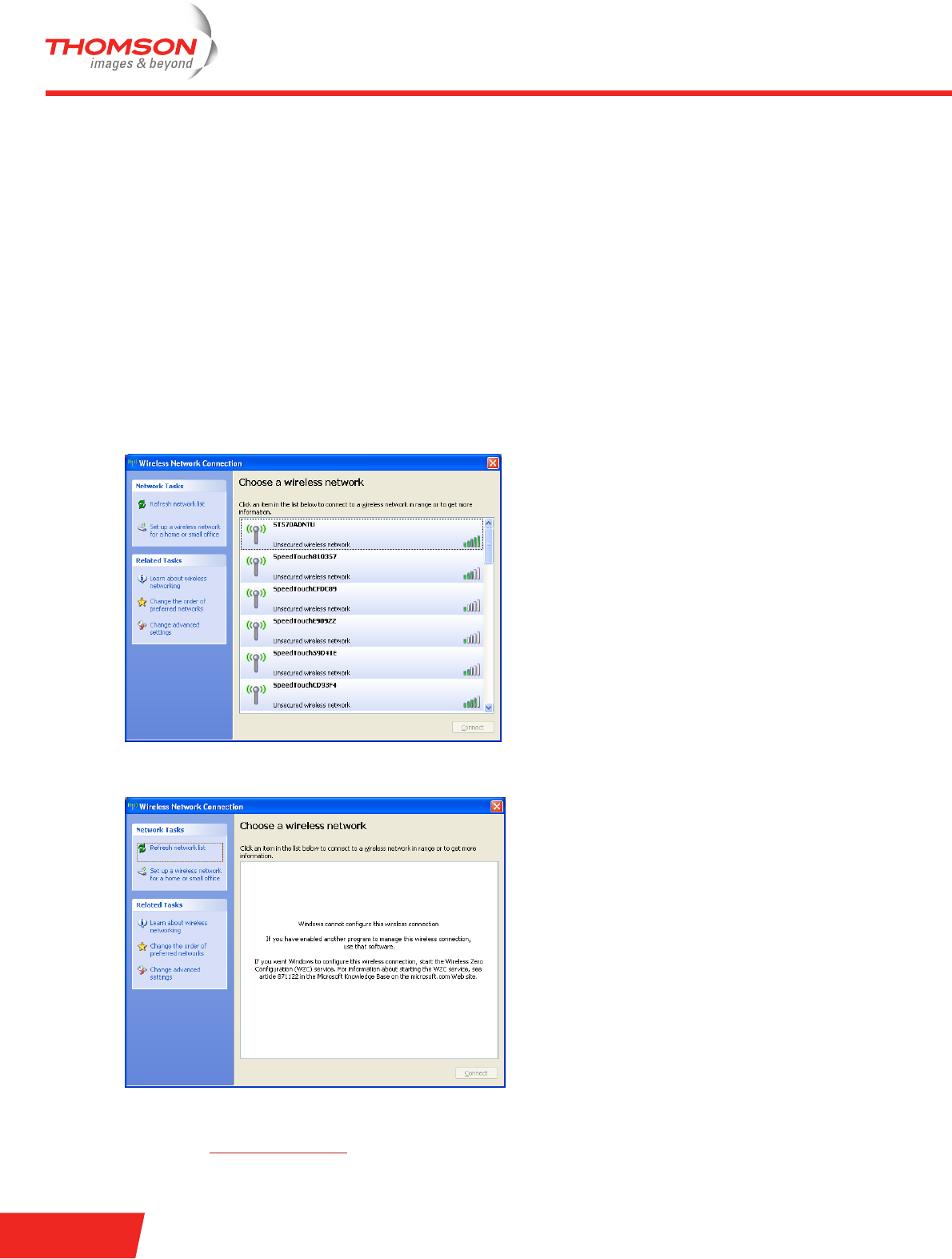
E-DOC-CTC-20060911-0041- v1.0
Chapter 4
Troubleshooting
38
4.5 Windows Zero Configuration
About Windows Zero Configuration (WZC)
The Windows Zero Configuration (WZC) service allows you to automatically configure your wireless
connections. WZC is a part of Windows XP SP 2 and above. When you install a Thomson Gateway wireless
networking product, it will automatically use WZC whenever possible. If not, a dedicated client utility is
installed.
How to Open the WZC Service
By default, WZC should be active. To open the service click Start > Connect to > Wireless Network
Connection.
This opens the Wireless Network Connection window :
The installation of your wireless network adapter may have disabled WZC. In this case,the following will
appear:
You should use the utility corresponding with your wireless network adapter to connect to your wireless
network, or restore WZC. Refer to the documentation of your wireless product and the microsoft knowledge
database on www.microsoft.com for more information.
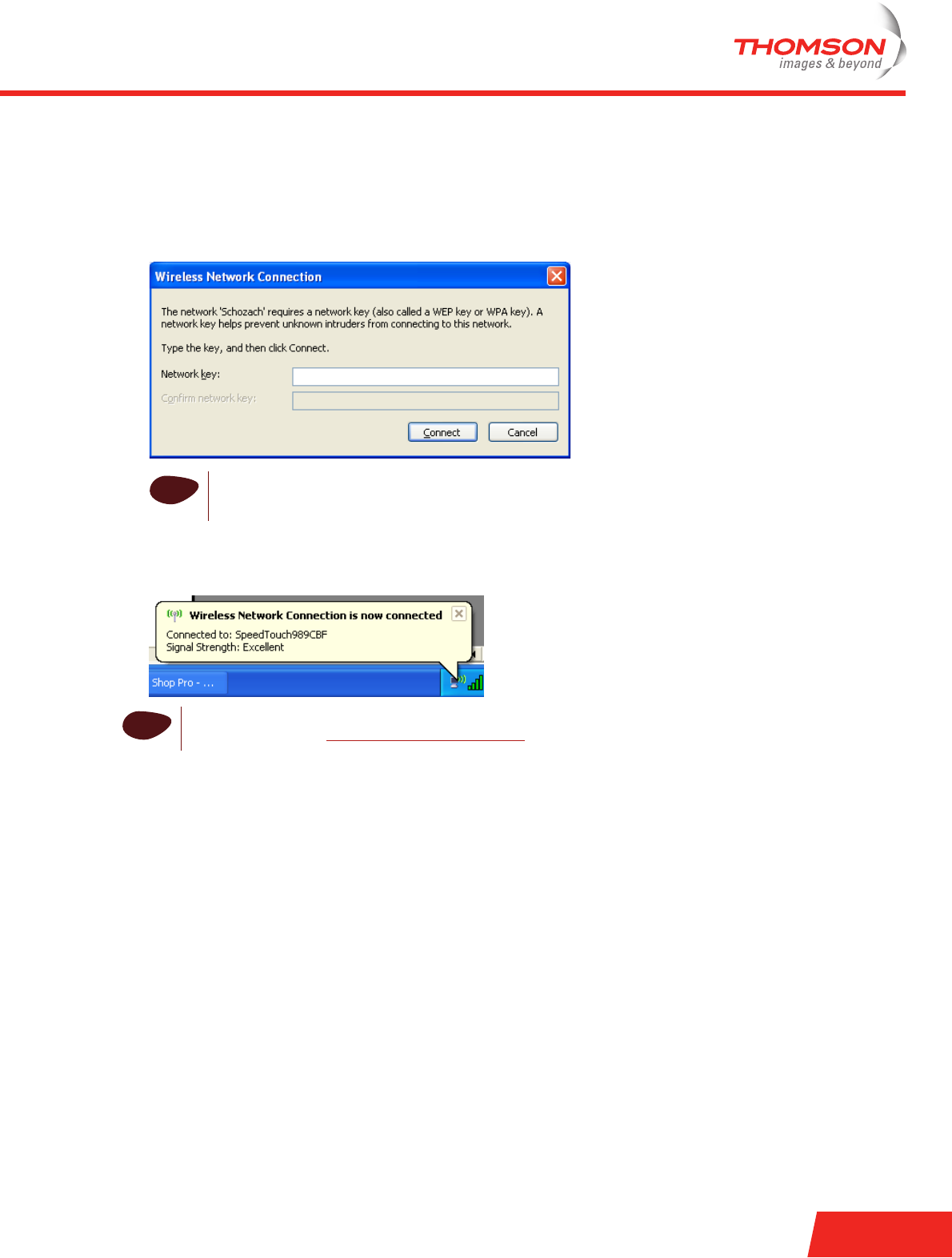
E-DOC-CTC-20060911-0041- v1.0
Chapter 4
Troubleshooting
39
How to Establish a Wireless Connection using the WZC
Proceed as follows to start and use the WZC service:
1Open the Wireless Network Connection window (see above)
2From the list, double-click the network you wish to connect to, or select it and click Connect.
Result: The WZC may prompt you for an SSID and a WPA or WEP Key (in case of a secure network):
3If applicable, fill in the SSID and the key and click Connect.
Result: a wireless connection to your Thomson Gateway will be established. When the connection is
ready, Windows informs you through a popup balloon in the notification area:
iThe typical SSID is SpeedtouchXXXXXX where XXXXXXrepresents a set of alphanumerical
characters. You can find the SSID and the key on the label on the bottom of the Thomson
Gateway.
iFor more detailed information about starting and using the WZC service, visit the Microsoft
knowledge base on http://support.microsoft.com.

E-DOC-CTC-20060911-0041- v1.0
Chapter 4
Troubleshooting
40
4.6 Easy Setup Troubleshooting
Prerequisites
Before you run the Easy Setup on the embedded Thomson Gateway pages, make sure that:
>The necessary connections are made.
>The Thomson Gateway is turned on.
>Your host computer is configured as DHCP client or with a valid fixed IP address.
Supported Web browsers
Your Web browser must be able to run JavaScript.
Disable proxy server
The Easy Setup only works if the proxy server is disabled or bypassed for local addresses. For more
information, refer to the Help of your Web browser.
Proceed as follows to disable a proxy server in Internet Explorer:
1In the Internet Explorer menu, choose Tools > Internet Options.
2Click the Connections tab.
3Click the LAN settings... button.
4Clear the Use proxy server box and the Use automatic script box.
iIf you have any problems, you can give the host computer a fixed IP address in the same subnet as
your Thomson Gateway (If the Thomson Gateway is in its default settings, that is an address
between 192.168.1.1 and 192.168.1.253).
If you use fixed IP addresses, the Thomson Gateway has to be configured as DNS server (default).
!It is recommended to disable all other network connections on your computer first, except the one
connecting to your Thomson Gateway.
Proceed as follows to disable a network connection:
1In the Windows XP taskbar, click the Start button.
2Choose (All) Programs > Control Panel > (Network and Internet Connections >) Network
Connections.
3Right-click the network interface icon you want to disable and choose Disable.
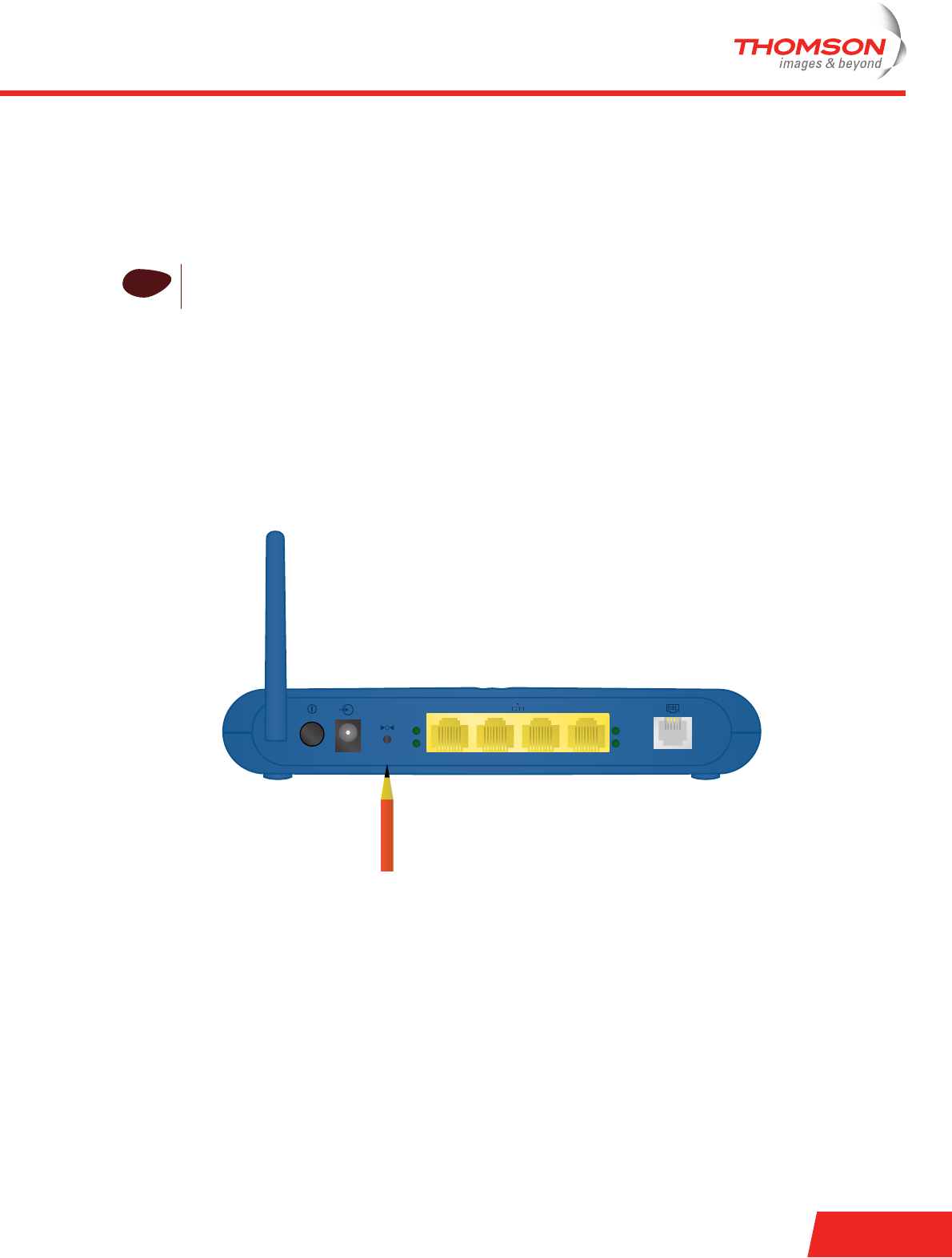
E-DOC-CTC-20060911-0041- v1.0
Chapter 4
Troubleshooting
41
4.7 Reset to Factory Defaults
Resetting your Thomson Gateway
You might consider a reset to factory defaults as described below.
A reset to factory default settings deletes the configuration profile settings. Therefore, after the reset, a
reconfiguration of your Thomson Gateway will be needed.
Reset to default configuration
Proceed as follows:
1Make sure the Thomson Gateway is turned on.
2Use a pen or an unfolded paperclip to push the recessed reset button on the back panel. The reset button
is marked with a red circle. Push it until the power LED lights red - this will take about 7 seconds.
3Release the reset button.
4The Thomson Gateway restarts.
!Be aware that a reset to factory defaults will revoke all configurational changes you made to the
Thomson Gateway.
Ethernet
1432
DSLReset
1
2
4
3
ON/OFF

E-DOC-CTC-20060911-0041- v1.0
Chapter 4
Troubleshooting
42

